Quality of the Environment in Japan 1996
Part I
Prologue A Sustainable Future and Today's Environment
The Troubled State of the Global Environment and Future Prospects
It has been four years since the Earth Summit was held in Rio de Janeiro in 1992. Although there have been various efforts made, both domestically and internationally, new scientific findings have revealed that the current state and future prospects of the global environment do not encourage optimism. In order to realise a sustainable future it is necessary that we make ever increasing efforts.
For instance, regarding the issue of global warming, the amount of CO2 emitted by both developed and developing nations is still on the increase. The second evaluation report of the Intergovernmental Panel on Climate Change (IPCC) in 1995, announced that a significant amount of evidence existed to show that global warming is starting. It is esti-mated that if the amount of greenhouse gasses continues to increase at the present rate, by the end of the 21st century, the mean temperature of the Earth's surface will have risen by an average of 2 degrees Celsius. The sea level will have risen by an average of 50cm. These phenomena will lead to very wide-spread and serious consequences. To prevent these consequences, it is necessary to delay until the end of the 21st century, the time when the amount of CO2 emissions achieve levels dou-ble that of the pre-industrial revolution environment. Even if this is done and CO2 levels stabilize at this level thereafter, it will still mean that by the end of the 21st century, levels of CO2 emissions have to be below the 1990 level and yet there still will be a need for further reduc-tion.
Lessons Learnt from Minamata Experience
There has been an effort to achieve a political solution regarding the Minamata disease issue, the origin of pollution problems in Japan, and a final and thorough agreement has been reached between the sec-tors concerned. Given this agreement, a Cabinet meeting in December 1995 reached consensus and agreed to execute the necessary measures. The Minamata disease not only caused serious health hazards but also initiated a wide range of major effects such as the destruction of the ties that previously held the community together. A tragedy like this pollu-tion case should never be repeated.
Large-scale irreversible effects are expected to result from the en-vironmental problems of today, particularly so in the case of global envi-ronmental issues. At the same time, scientific uncertainty is inevitably given the nature of these issues and problems. Learning from the Mi-namata experience, it is necessary to promote preventative measures while, simultaneously, continuing to make further efforts for scientific elucidation of the problems that face us.
Importance of Partnership
The establishment of the Basic Environment Law and the Basic Environment Plan has provided a new set of basic ideas for environ-mental policies, and has established a framework and the long-term course for these policies. The next task is establishing how to put these policies into action. Previously, pollution problems were regional and the resulting damage was easy to see. It was therefore relatively easy to appreciate the causes and effects. By contrast, many of today's environmental problems are caused by the intertwined activities of the many different elements that go to make up today's huge and complex economic soci-ety. In order to solve these contemporary problems, partnership is an important key. Partnership in this case involves various elements in so-ciety working together in co-operation and sharing responsibilities. It also involves understanding the relationship that exists between the daily lives of individual citizens and the natural environment, and also the connection that exists between the broader range of socio-economic activities and the environment. Human lives have always been dependent on the environment in every part of the world. It is absolutely essential for us to take note of, and understand, the relationship that exists between the environment and ourselves, and to open a path for a sustainable future with the ac-tive co-operation of all people.
Chapter 1 Rich Human Life Dependent on the Environment
Section 1. Our Daily Lives and the Environment
1. Changes in the Quantity and Quality of Food Consumption
First of all, let us look at our food as an example that highlights the deep relationship that exists between our daily lives and the natural environment. In recent years, there have been only slight changes in levels of food supply and consumption in Japan, which means that 'food consumption has reached the maximum level. If we look at this situation more closely, we discover that consumption levels of vegetable foods has not changed, or has shown signs of decreasing, while the consump-tion levels of food derived 'from animals has increased substantially. This data indicates that people are now consuming a wider variety of food items, including more food derived from animals. One reason for this change in food consumption patterns is the fact that it has become possible to obtain food regardless of seasonal change or regional location. In the case of tomatoes, to cite one instance, monthly market supplies show that supply is less affected by seasonal change than in times past. The reasons for this phenomenon are firstly, an increase in the amount of green house cultivation and other artifi-cially manipulated methods of production, and secondly an increase in the distance between the area of production and the area of consump-tion. Increase in dining-out and eating alone or in small families is an-other change in food consumption patterns.
Fig. 1-1 Monthly Amount of Vegetables Available in 1965 and 1994 (At the Tokyo Central Wholesale Market)
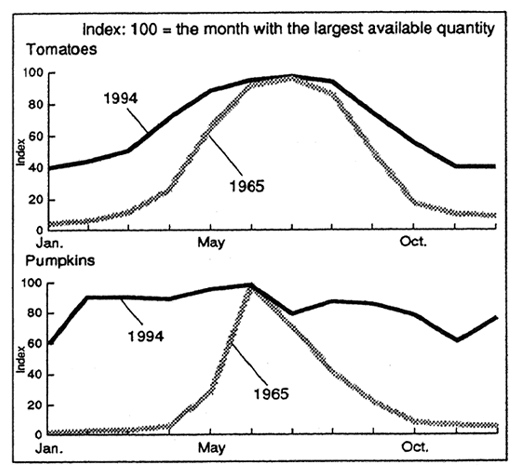
Note Figures 'from 1965 include minii-tomatoes.
Source: Compiled by the Environment Agency from "Annual Reports of the Tokyo-Central Wholesale Market" compiled by the Tokyo Metropolitan Government.
Fig. 1-2 Changes in Percentage of Vegetable Producing Districts Dealt at the Tokyo Central Wholesale Market
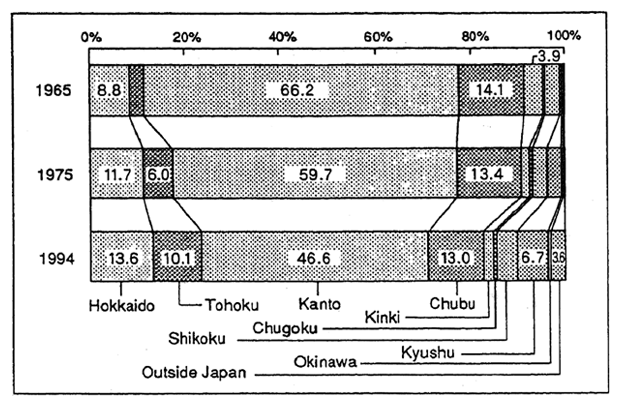
Source: Compiled by the Environment Agency from the Tokyo Central Wholesale Market Annual Statistics of Agricultural Products
2. Changing Position of Food Production in the Environment
These changes in our eating habits have contributed to improv-ing our food levels and living standards. However, they have also made it difficult for us to appreciate the fact that our food is a result of a rich and healthy environment. Artificially manipulated production methods, especially green-house cultivation, combined with the increasing distance between zones of cultivation and consumption, have raised the levels of energy con-sumption necessary for the production and transportation of foodstuffs. This is resulting in an increased strain on our environment. Another problem is the waste that is generated in the form of food containers and packaging.
In addition, electrical products for cooking and preserving food have proliferated throughout our society. While, on one hand, this has contributed greatly to the reduction of the domestic work load, on the other hand it has resulted in an increase in environmental load in the form of increased energy consumption. Nowadays, many people are purchasing bigger refrigerators to store a large amount of food at home. One survey result reveals that a 'high percentage of the younger gen-eration automatically, and without consideration, disposes of all food for which the "good until" date has expired.
Fig. 1-3 Amount of Energy Needed to Produce 1 kg of Cucumbers (1990)
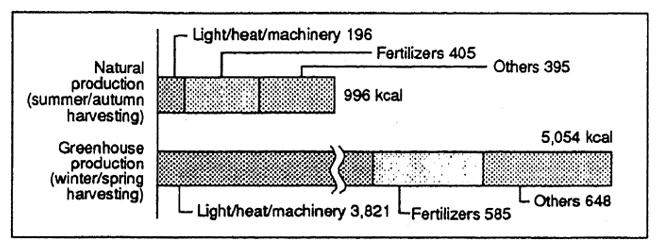
Source: Compiled by the Environment Agency from the Estimated Amounts of Energy Necessary for Agricultural Production in "Lifestyle Energy in Family Life" by the Resource Association
3. Food and the Environment from a Global Perspective
Problems such as unsustainable forms of production/consump-tion, poverty, and the population increase have become global issues. According to the United Nations Development Programme (UNDP) , ap-proximately 800 million people cannot obtain sufficient food to meet their basic nutritional needs on a daily basis. Poverty prevents people from thinking about the environment and the pressure to increase food production as the population expands has become a major cause of envi-ronmental load, forcing people to cultivate crops on environmentally fragile lands such as high land, tropical forests and semi-arid lands.
Table 1-1 Change in Farmed Land Areas in the Philippines (Low Land/High Land)

Source: Maria Concepcion Cruz, Carrie A. Meyer, Robert Repetto, et al., Population Growth, Poverty, and Environmental Stress Frontier Migration in the Philippines and Costa Rica (World Resources In-stitute, Washington, D.C., 1992)
Fig. 1-4 Causes of Soil Degradation (World)
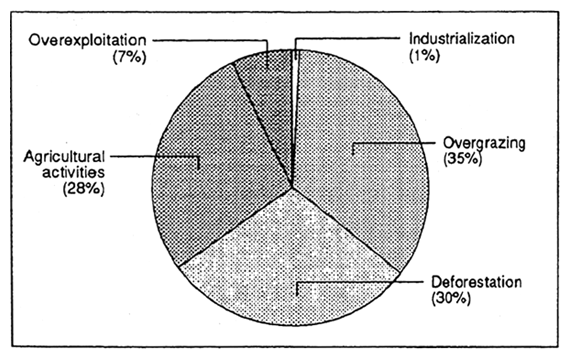
Source: World Resources 1992-93 (World Resources Institute)
In developing countries there are some cases where inappropri-ate methods of export food production are causing environmental prob-lems. For instance, many coral reef fishes used in restaurants in Hong Kong are caught in south east Asia using toxic cyanide. Cyanide fishing is a highly questionable practice. It has a serious effect on the marine ecosystem as a whole, including coral reefs. It is said that some orna-mental fishes imported to Japan are also caught by this method.
4. Japan's Food Imports and Nitrogen Circulation
Any increases in Japan's food imports are becoming more de-pendent on the environments of those other countries which produce food for Japanese tables. Food import forms a major flow in nitrogen cir-culation which is closely related to some environmental problms. This is not to say that the nitrogen released in the stages of food supply and consumption directly exerts pressure on the environment. However, in-creases in the rates of nitrogen release caused by increases in food im-ports and the resulting quantities of waste water is thought to be ~n in-direct cause of nitrate nitrogen pollution in underground water and of the eutrophication of lakes and inner bay ares.
Fig. 1-5 Food Supply/Consumption Process Based on Nitrogen Flows (1992)
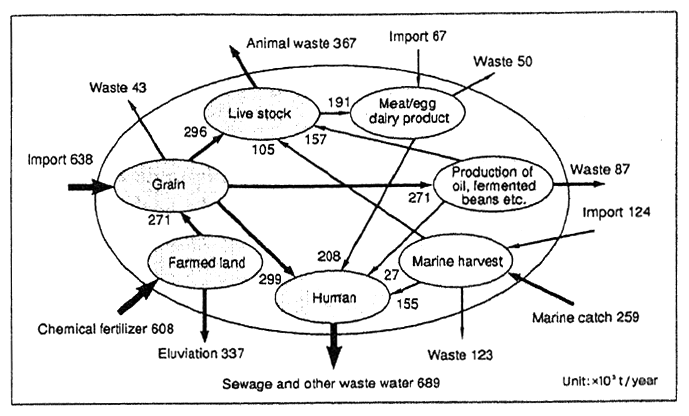
Source: National Institute of Agro-Environmental Scienecs Food Supplies and Nitrogen Circulation in Japan from the Japan Society of Envi-ronrnental Science Journal Volume 9, No.1
5. Changing Eating Habits so that They Become Integrated in the Process of Natural Circulation
Originally, living organisms consumed nutrients as part of the process of natural circulation. Food was a blessing from nature and was eaten, assimilated into the body and the waste products were then re-turned to the natural environment. In modern times, this natural circu-latory process has become increasingly difficult to actually see, with the result that individuals find it hard to conceptualise the link that exists between the food they eat and the natural environment that has pro-duced it. In this situation, where eating and nature have become, or have appeared to become, completely separated, some people hay. started to rerecognise the link that exists between eating and the envi-ronment. Recently there have been some signs of a tendency towards changing eating habits and in the process re-establishing eating as part of the cycle of natural circulation.
At the household level, for example, eco-cooking" has been pro-moted by some local governments. Eco-cooking offers ways to make kitchens environmentally sound by fully utilising seasonal ingredients with minimum wastage, and using oil and detergent in an environmen-tally friendly way.
Also, as environmental awareness and interest in food safety in-crease, people are encouraging nature-oriented forms of agriculture (which utilise low levels of chemical fertilisers and pesticides) through direct purchase systems of agricultural products from producers. Be-cause, under the direct purchase system, producers and consumers ac-tually know each other, consumers recognise the importance of the en-vironment that produces their food and, at the same time, producers can feel that protecting the production base, the environment, leads to the protection of consumer health. Therefore, through the medium of agricultural products, local environments can be shared by both produc-ers and consumers. Various regions are promoting container recycling, the reuse of bottles and the composting of organic waste.
6. Towards an Environmentally Sound Lifestyle
Regarding the pressure on the environment that is posed by peo-ple's day to day activities, the amount of 002 and nitrogen oxides emit-ted by an average household was calculated. The calculation revealed that activities outside the house, particularly automobile use, are the major contributors of these emissions.
Our daily life at the household level is a major source of environ-mental pressure on a nation-wide scale. Household electricity use, CO2 emissions resulting from the production and transportation of daily commodities, air pollution from automobiles and water pollution from household effluent-all exert pressure on the environment.
In today's huge and complex economic society, our own individ-ual lifestyles might appear to be trivial and without influence. However, by making our lifestyles more environmentally friendly we have the po-tential power to change society as a whole. If we look at the water re-source use pyramid, we can see the enormous amount of water used in our society, including our households, compared with the amount of water that is basically necessary to sustain our lives as living things. These pyramid models show that the way we conduct our social/eco-nomic activities has a tremendous impact on the environment.
Although our daily lives are intrinsically connected to the global environment, many people are not conscious of this fact. Furthermore, many people do not even spend much time considering the impact that our consumption and behavioural patterns can have on the environment.
Fig. 1-6 Trends in CO2 Emission by Sectors in Japan
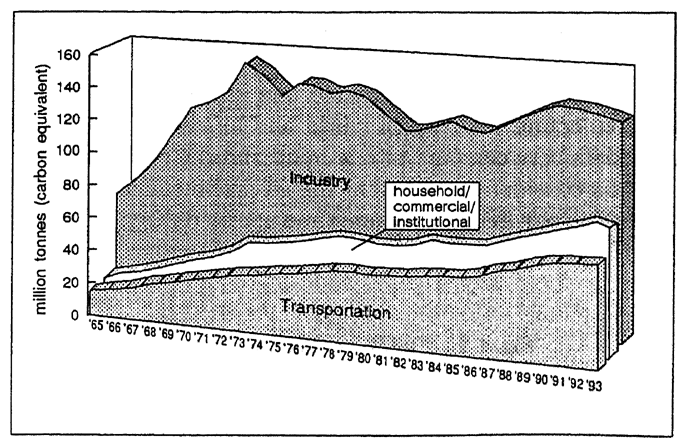
Source : Environment Agency
Fig. 1-7 Pyramids Showing Water Resource, Energy, and Waste Consumed or Produced Per Person Per Day at Different Levels in Japan (1992)
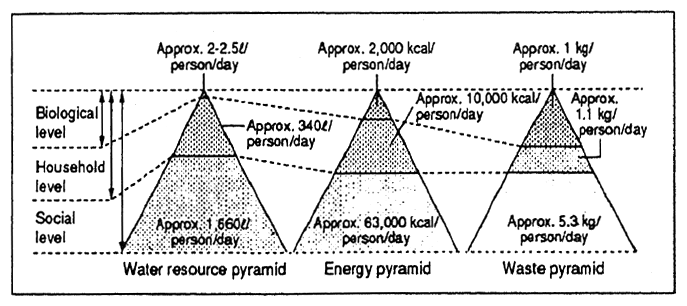
Source: Adjusted from "The Global Civilization Vision" Koyu Furusawa
It is urged that everybody should work to create a more environ-mentally sould lifestyle. To achieve this goal, it is necessary to start by looking closely at the relationship which exists between the environ-ment and humankind and to review whether this relationship is in tune with the providence of nature.
Section 2. Childhood Play and the Environment that Nurtures Rich Minds and Spirits
1. Relationship between Rich Minds and the Environment
Economical considerations aside, one important aspect regarding the links connecting the natural world and humankind is the relation-ship that exists between our state of mind and the environment. In this section, let us consider the role that the environment plays in the proc-ess of nurturing our minds, character and spirits during childhood play.
Fig. 1-8 Childhood Playing Areas
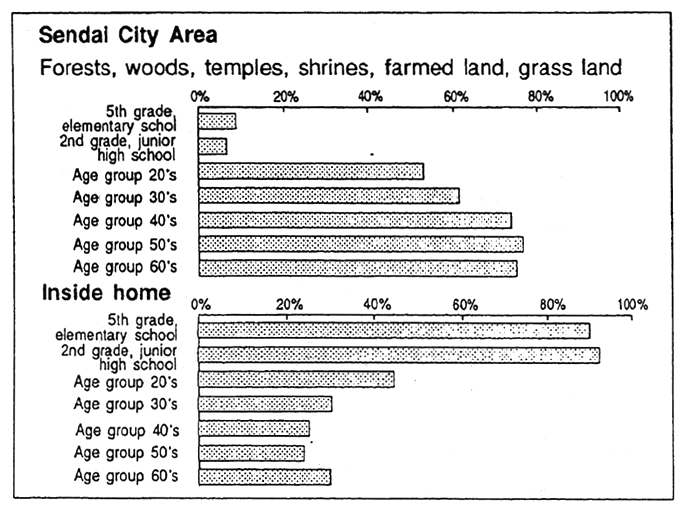
Source: Environment Agency
Fig. 1-9 Lack of Nature Experience
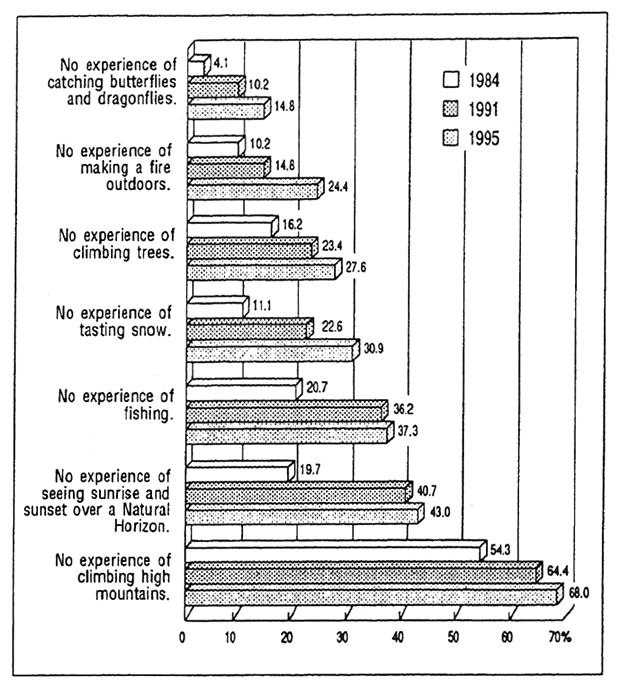
Source: Compiled by the Environment Agency from the "Surveys on Na-ture Experiences/Life Experiences"(1995) by Tetsuro Saito, et al.
2. Decreasing Nature Experience in Children's Play
Childhood play offers important opportunities for young human beings to interact with their peers and their natural environment, and, in the process develop character and spirit. However, as the environ-ment changes, children's styles of play are changing too.
An Environment Agency survey revealed that more childrcn nowadays are playing indoors rather than out. Moreover, television games have taken over other forms of play which use natural materials such as animals and plants. The result is a tendency for children's play to become less diverse and, nationally, more uniform.
Looking at quantitative changes in children's play styles in 1975, the amount of play space available for a child was only one twentieth of the amount available according to figures from 1955. A survey in Yoko-hama shows that the space has halved again since 1975. In particular, a decrease in natural space, such as rivers, forests and farmed lands, is highly prominent Also, a decrease in time spent playing outdoors is very noticeable.
Fig. 1-10 Changes in Children's Playing Time
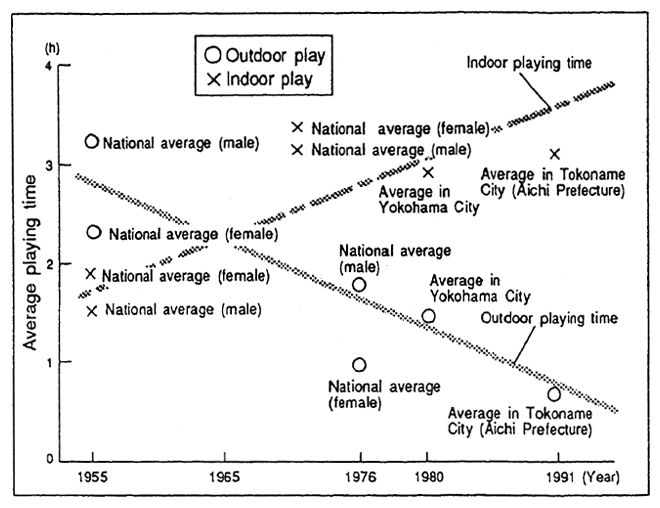
Source: "Children and Play" by Mitsuru Senda
Reasons for these changes are thought to be connected to a wide range of changes in socio-economic structures. Development and urban-isation, fast popularisation of television sets, erosion of the amount of time families have in which to interact, and over-heated competition for school/university entrance are some examples of these socio-economic changes.
3. Nature Experience and People's Perceptions of Nature
A survey conducted by the Environment Agency revealed that the present generation of Japanese parents knows far more flower names than its children. This result shows how important it is to pass on feelings and experiences regarding the natural environment and sea-sons. The survey also shows that the more nature experience one has, the more one is inclined to put priority on environmental conservation, rather than other forms of wealth. Playing in a natural environment during childhood nurtures an early appreciation and affection towards nature. It also enables a child to perceive and understand the relation-ship that exists between humanity and the natural environment.
Fig. 1-11 Decrease in Playing Areas in Yokohama
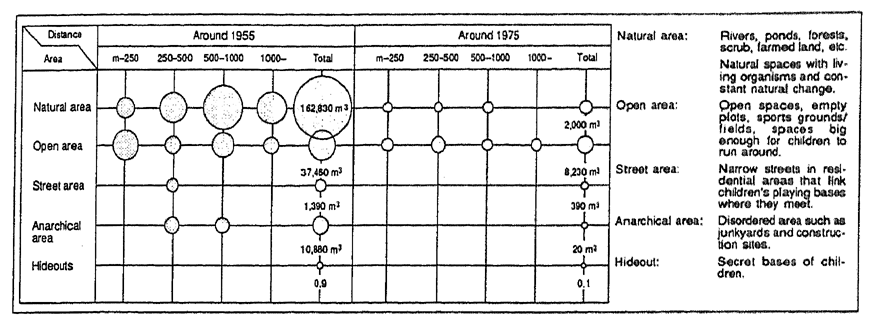
Source : "Children's Playing Areas in Cities" by Mitsuru Senda
Fig. 1-12 Relations between Nature Experience and Attitudes towards Environmental Conservation
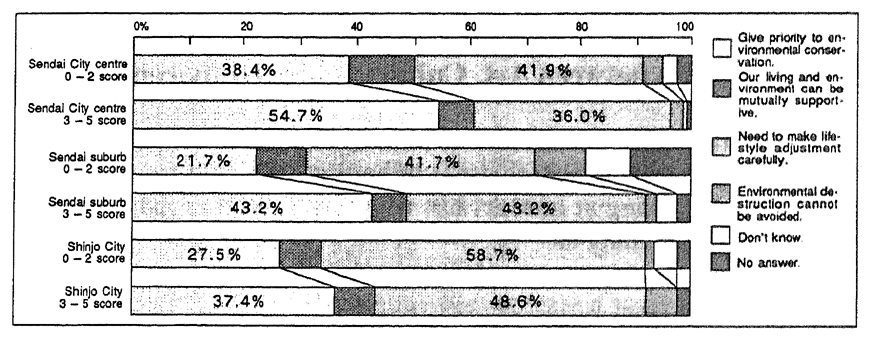
Note: Ranked from average scores of children from 29 selected outdoor plays. 0-2 score: With virtually no experience of playing in natural environment. 3-5 score: With experience of playing in natural areas near house.
Source: Environment Agency
4. Securing Natural Playing Sites
For children to be able to play in a natural environment that will nurture healthy minds and bodies, it is important to secure natural play-ing spaces. The Setagaya Ward in Tokyo manages play parks which have an open grassland space. In each play park, an official play leader is permanently present in order to create a good environment in which children can play, to give advice to children when trouble occurs and to provide first aid in the event that a child sustains a cut or other injury. Through playing in nature children make friends, acquire play-ing techniques and also acquire the ability to appreciate the shapes, col-ours, structures and changes of nature. At the moment, there is a ten-dency to eliminate playing space with a view to seeking economic effi-ciency and personal convenience. Given these current circumstances, our task is to conserve and restore our environment, in order to secure natural playing space. Such areas are, and should be, full of diversity and unpredictability and offer places where children can seek the real pleasure of playing.
Section 3. Art, Culture and the Environment
1. Relationship between Art, Culture and the Environment
Art is an expression of human spiritual activities. In this section, let us consider the relationship that exists between art, culture and the en-vironment by looking at how art has represented the environment and what it has been telling us.
2. The Challenge of Environmental Art
In modem art, there is a new challenge to create art in the natu-ral environment. This has been called environmental art. One form of environmental art is to use existing forms of art to speak about the envi-ronment, in the form of environmental video, environmental plays etc. Another form is to make the environment itself into art by the manufac-ture of natural object d'art, earthwork, etc.
Earthwork emerged in the late 1960 s in the United States and the United Kingdom. This has taken art work out of exhibition spaces such as art museums and tried to put it face to face with the global envi-ronment. Behind the emergence of this form of art, there was a philoso-phy critical of establishments such art museums and existing art works which were perceived as commercial products. Earthwork also tries to express people's feelings about the global environment and their urge to sympathise with nature.
3. Links between Literature, Music and the Environment
In the field of literature, since the 1960s, the so called genre of "nature writing" has become popular in the United States. Nature writ-ing comes in the form of essays and non-fiction literature concentrating on nature-related topics. Nature writing has the ability to convey en-lightenment on the subject of human life by examining the interaction of people with nature.
In the field of music, in the late 1960s, the concept of environ-mental music started to emerge. Also, the notion of "Soundscape" ap-peared -a landscape captured not with eyes but with the ears, effec-tively resulting in a landscape of sounds. Soundscaping tries to capture and portray the changes in sound that occur between different times and regions and, by doing so, promotes interaction between human be-ings and the environment of sound. It also tries to portray the states of regional societies, cultures and consciousness through the medium of sound.
4. Environmental Changes that Damage Cultural Heritage and Art Works
Human induced environmental destruction has damaged a num-ber of cultural heritage and art works that have been built up over a long period of time. In Dunhang Mogao Grottoes in China, which is a world renowned treasury of Buddhist arts, wall paintings in the Grot-toes have cracked and parts are coming down. It has ben revealed that a main reason for the damage is water. It is feared that if the global warming induced rainfall increase causes intensive downpours, damage to the wall paintings might well accelerate.
In Egypt, the construction of the Aswan High Dam has resulted in the salinisation of the Nile valley. Giza on the lower Nile is world fa-mous for its pyramids and the sphinx. There are fears regarding the possibility of the head of the Sphinx actually falling off due to salt crys-tallisation in the cracks of its stones.
Moreover it has been reported that in many countries, acid rain has inflicted major damage on art works. The famous corrosion of the stone statue on the Earthen Castle wall in Germany is a good example.
We are losing our precious cultural heritage and art works be-cause of global environmental problems.
5. Inheriting the Environment as a Basis of Rich Spiritual Activities
As we have seen, various connections exist between the environ-ment and art/culture. We have also seen that environmental changes could result in damage to the value of our cultural heritage and art works, and, in some instances, even ruin them completely.
We have inherited a rich environment and similarly it is up to us to leave an equally rich environment to the next generation, for such an environment is the basis for rich, spiritual activities.
Chapter 2. Environmental Conservation from the Viewpoints of Biodiversity and Eco-Efficiency
Section 1, Biodiversity and Human Life
1. What is Biodiversity?
The word biodiversity embraces three kinds of divirsity ; (1)the diversity of the world's species such as animals, plants and micro-organisms, (2)the genetic diversity of these species, (3)the diversity of regional ecosystems.
i. Species diversity can be measured by the number of species found living in a certain area. At present, around 1.75 million species arc scientifically described in the world. However, It is estimated that 10 million to 100 million species actually exist on the earth.
ii. Genetic diversity means that different genes could result in dif-ferent shapes and colours emerging among individuals of the same spe-cies. Genetic diversity affects the adaptability of a specics to environ-mental changes.
iii. Ecosystem diversity refers to the diversity of ecosystems estab-lished in different environment such as forests, grasslands and oceans. Species diversity is highly influenced by the ecosystem diversity of an area.
Fig. 2-1 Number of Described and Possibly Existing Species for Major Groups of Organisms
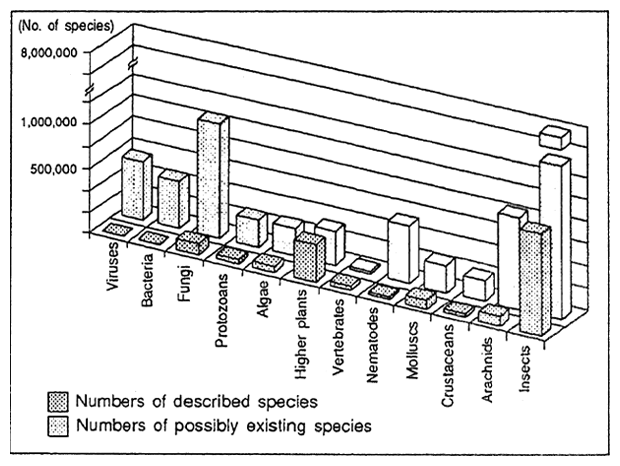
Source: Global Biodiversity Assessmcnt, UNEP
Since the first life-form appeared on the Earth, about 4 billion years ago, living things and the environment have influenced each other and changed each other a great deal. Nature possesses the power to heal itself, even if it has been damaged once to a certain degree. The source of this recuperative power is embodied in the power of diversi-fied living things which can adapt themselves to different environments.
2. Benefits of Biodiversity
Our life depends on the benefits brought about by biodiversity. These benefits can be categorised as follows:
(1) Formation and Adjustment of the Environment
The activities of living organisms create and adjust an environ-ment making it habitable for all living things, including humans. Living organisms create soil, rivers, underground water, and oxygenate the at-mosphere. They also regulate climate.
(2) Productive and Economic Value
Many resources necessary for our daily lives and economic ac-tivities come from living things. These include food, clothes, medicines, oil, coal, etc.
(3) Cultural Value
Human beings have always learnt of the providence of nature, have nurtured a sense of beauty and other feelings through their inter-action with nature. Nature has always been an object of art and worship, as well as a place for recreation and rest.
At present, considering the large number of species existing in the world, humankind has only utilised a very small percentage of the total species, be it for agricultural products, cattle, medicines etc. This predominant monoculture has resulted in a loss of regional diversity and this has made agriculture very fragile when it comes to resisting environmental changes and pests. To take another instance demon-strating the importance of biodiversity, a new remedial substance for cancer has been found in a plant species that, in the past, was ignored. This shows that there is a strong possibility that some unknown species might have some property which is crucial for human survival in the fu-ture.
Given the fact that the health of the global ecosystem depends on biodiversity, it is essential for humans to obey the providence of natural diversity and to conserve it. Only by doing this, does it become possible to build a sustainable and affluent society.
3. Biodiversity in Japan and Human Life
Japan has very rich biodiversity. Its land is long and mountainous. It has diversified climate zones ranging from the sub-tropical to the sub-arctic. Japan has four distinct seasons. All these factors have resulted in rich forests. Moreover, Japan's geological history of joining and separat-ing from the main Asian continent has also contributed to this country's biodiversity.
Over many yeans, a natural environment has been sustained alongside the activities of Japan's human inhabitants. Paddy fields, the footpaths and streams between rice paddies, and small mixed wood-lands are somc examples. Animals such as dragonflies and killifish thrive in this human-influenced environment, and, through first hand human interaction with this type of nature, a traditional sense of nature was shaped in Japan, in which the natural world and humankind were perceived as one.
4. Disappearing Biodiversity and Conservation Efforts
During the 4 billion-year history of life on this planet, many spe-cies have bccome extinct due to environmental changes. This said, how-ever, it is estimated that the speed of human induced extinction of spe-cies has been 50 to 100 times as fast as the natural extinction rate. Some tens of thousands of species are. said to be in the process of extinction due to causes such as habitat loss.
In order to preserve biodiversity, it is important to protect spe-cies in their natural habitats. Any utilisation of species must be sustain-
able and must fall within the regenerative capacities of species and eco-systems. To achieve biodiversity conservation, it is necessary to have well-planned regional strategies to sustain the environment as a whole rather than trying to protect each species individually.
In order to protect animals, plants and the natural environment various international agreements have been signed, such as the Wash-ington Convention, the Ramsar Convention, and the World Heritage Convention. In addition, in 1993, the Convention on Biological Diversity was enforced. Reacting to the terms of this convention, Japan estab-lished the National Strategy on Biological Diversity in October 1995.
Fig. 2-2 Mass Extinctions and Affected Animal Groups
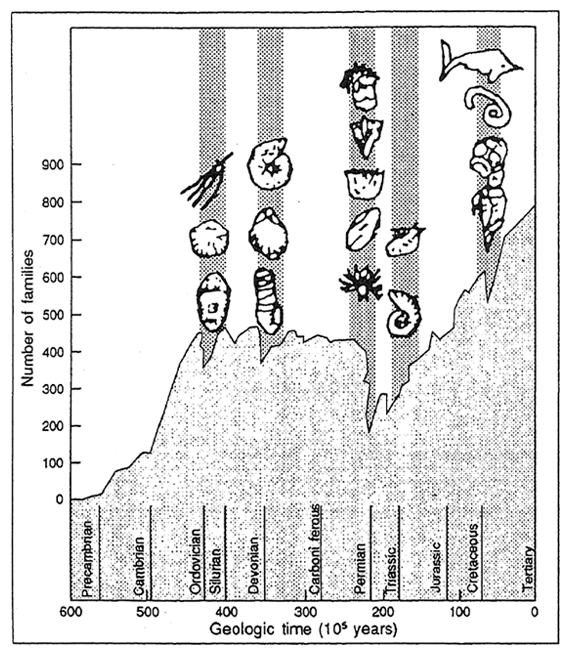
Source: Global Biodiversity Assessment. UNEP
The National Strategy on Biological Diversity lays down long-term goals and future efforts, and systematically outlines the measures to be undertaken by each government ministry and agency. Addition-ally, the Strategy aims to help people become interested in, and under-stand, the issue of biodiversity conservation. Furthermore, it promotes the work of local governments, commercial enterpriscs and non-gov-ernmental organizations (NGOs) on the biological clivcrsity issue.
Table 2-1 Factors Driving Wild Animals to the Verge of Extinction causes Destruction Over-hunting Displaced by of habitat invading Lack of food Killed as pests Occasional
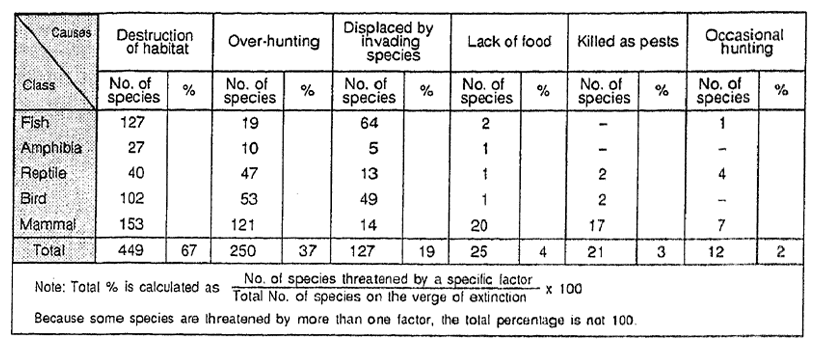
Source Ecosystem Conservation Society-Japan "Biotope Network" (it, IUCN 1986, Environment Agency 1990)
Fig. 2-3 Water/Greenery Eco Network: Securing Connection' between Ecosystems
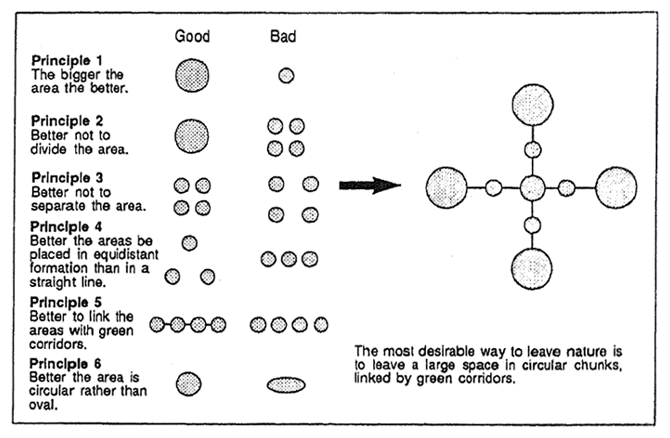
Source: Ecosystem Conservation Socicty-Japan "Biotope Nctwork"
The local government for Shiga Prefecture is working to pre-serve regional biodiversity in Lake Biwa area by making the most of the region's particularly local characteristics. The Prefecture is workir g to conserve reeds along the shore of Lake Biwa by designating the natural ecosystem a unique characteristic of the Shiga region. This effort is based on the Ordinance on Conservation of the Reed Colonies of Lake Biwa in Shiga Prefecture.
5. Rich Life in Harmony with Regional Nature
Although people are increasingly interested in environmental is-sues, this interest tends not to lead to concrete action such as protection and management of regional environments, according to a recent sur-vey on people's environmental awareness. Given this situation, there is a movement to look for new ways of interacting with nature, placing em-phasis on actual, first-hand experience of a natural environment. Eco-tourism, nature learning and nature schools are some examples of this trend. Eco-tourism offers people opportunities to have deep interaction with the nature and lifestyle/culture of the region visited without dam-aging or affecting the area. Nature learning involves understanding and interacting with nature.
Beside the Tama New Town area in Tokyo, the Yugi Farmers Club has been established. This Club aims to create an amiable region in which to live, making good use of the rich nature in the Tama heights area. To achieve this goal, the Club offers opportunities for dairy farm-ers and suburban residents to mingle, and for people to enjoy farm work.
For a long period of time, Japan has enjoyed a rich and colourful natural environment, and interaction between the Japanese people and the nature of Japan has resulted in a rich and diverse human culture. One way of creating a good regional environment is by reminding our-selves of the diverse and rich character of Japan's nature and culture through regional exchanges among residents. This will enable us to share our culture and nature with future generations. This will then help us to realise sustainable development and the preservation of global biodiversity.
Section 2. Making Economic Activities Eco-efticient
1. Towards an Economic Society with Full Consideration for Environmental Protection
Urban pollution and global environmental problems are caused by the fact that the mass consumption of resources and energy derived from modern socioeconomic activities is exerting pressure beyond the assimilative capacity of both the regional and global environment.
In order for us to achieve sustainable development within the natural constraints imposed by the limits of the global environment, it is necessary to change the present economic and social systcm which places primary emphasis on economic efficiency. Under thc new system, only necessary products and services must be produced and consumed, and this must be done so in a way that substantially decrcases pres-sures on the environment.
2. Internalizing Environmental Considerations in Corporate Activities
For commercial enterprises to make a continuous effort to de--crease pressure on the environment, it is necessary for them to estab-lish a system to devise original policies for environmental conservation, to check their own progress and to review their policies accordingly. It is also important that they inform society in general about their efforts. Environmental management systems are playing a major role in doing this. The International Organization for Standardization (ISO) is discuss-ing a move to enforce the ISO 14000 series in 1996.
Fig. 2-4 Changes in the Number of Companies Employing Some Form of Environmental Management System
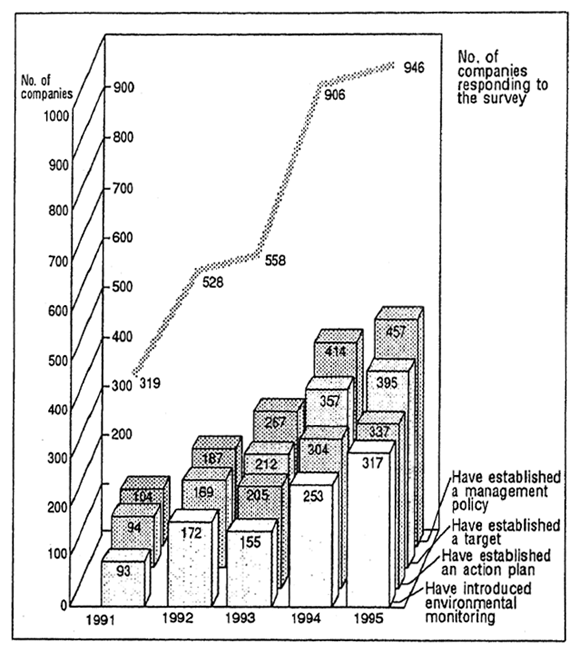
Source: Environment Agency
According to the Environment Agency's annual "Survey on En-vironmentally Friendly Actions of Companies," a steadily increasing number of corporations with listed stocks are adopting some form of en-vironmental management system. Moreover, around 30% of companies with listed stocks and approximately 15% of unlisted companies an-swered that they are planning to comply with the ISO Standards.
Fig. 2-5 Proposed Future Responses to ISO by Corporations with Listed Stocks
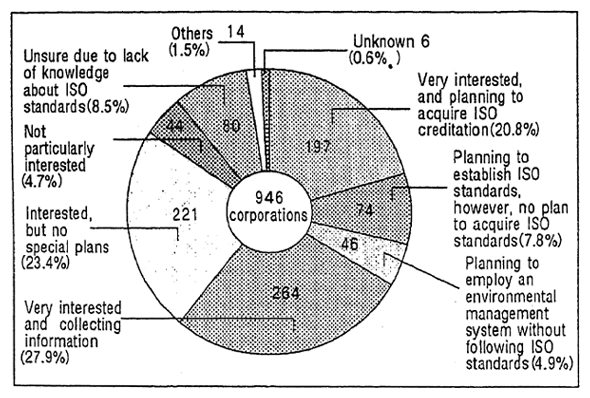
Source: Environment Agency
3. Eco-efficiency: Internalizing Environmental Costs and Increasing Quality of Economic Activities
Instances of pollution in the past have been overcome by techno-logical development and the investment of companies which were com-plying with reinforced environmental regulations. Internalisation of en-vironmental costs is often associated with economic trade-offs such as increased production costs. However, Japan's strict automobile exhaust emission control prompted rapid technological development, and this il-lustrates that trade-offs are not always inevitable.
Also, it is now becoming necessary to reduce the environmental load created through the whole life cycle of a product rather than just removing the pollutants that emerge at the end of the pipe. Internalis-ing more thorough environmental costs and reducing pressure on the environment by efficiently reducing these costs, results in economic ac-tivities based on "eco-efficiency." Eco-efficiency involves producing and consuming products and services while exerting a minimum of pres-sure on the environment.
Fig. 2-6 Investigation into Investment on Casting Processes Regarding Their Economic Efficiency : Trends in Effective Use of Cast Dust

Source: Environment Agency
Table 2-2 Environmental Investment to Expand Waste Sand Reuse
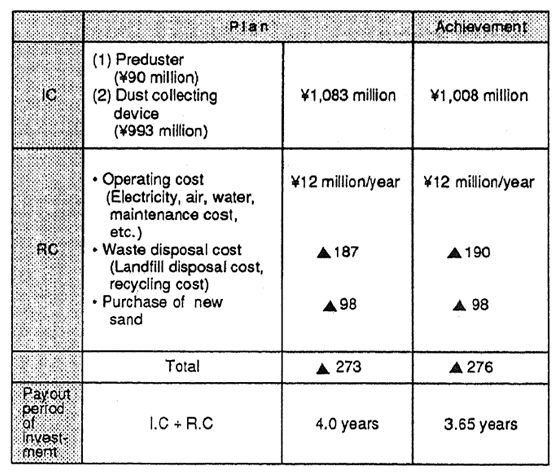
Source: Environment Agency
Fig. 2-7 1995 Survey on Environmentally Friendly Actions of Companies : Implementation of LCA
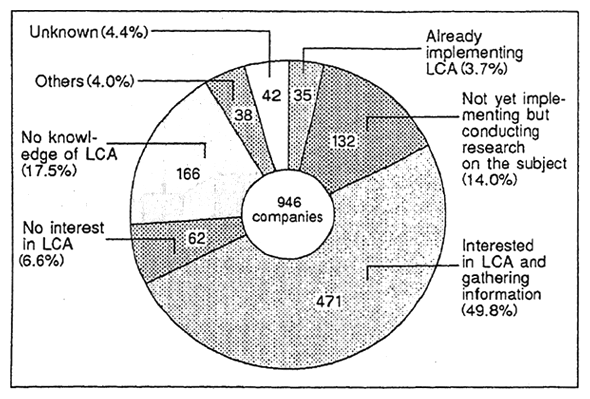
Source: Environment Agency
Fig. 2-8 Concrete Corporate Action for Conservation
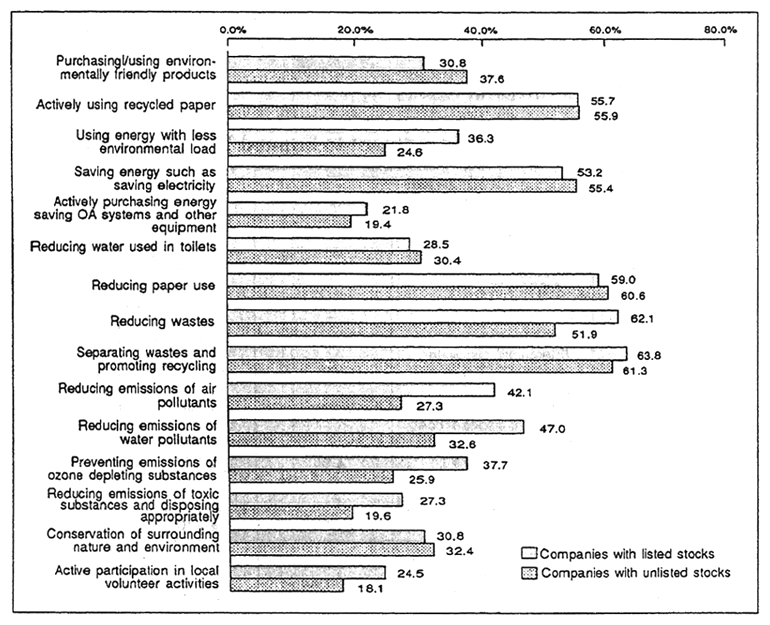
Source: Environment Agency
Moreover, preventive environmental technologies, which try to reduce or eliminate pollutants, make it possible to increase energy and resource efficiency in the production process. In the long term, this fur-ther increases the quality of economic activities.
One example of seeking eco-efficiency is investment in technolo-gies with less environmental load. Researchers have been working in fields such as Life Cycle Assessment (LCA) and Zero Emissions.
4. Challenges of Enterprises and Development of Eco-business
According to a survey on environmentally friendly actions of companies, about 60% of enterprises is working on measures such as the promotion of waste separation and recycling and reduction in paper use. These corporate measures to reduce pressure on the environment will ultimately increase economic efficiency through effective resource and energy use. Hence, in the long run, these efforts could be developed as a business which is supportive of the market theory.
According to the survey, about 40% of companies with listed stocks and around 20% of unlisted companies answered that they are developing some form of eco-business or working on research to de-velop eco-business. They are particularly interested in waste manage-ment and recycling. Of those listed companies that answered that they already have an eco-business, more than 40% says that profits from eco-businesses are bigger than in the previous year. Eco-businesses are ex-pected to show continuous growth in the future.
5. Government Measures Regarding Its Economic Activities
The Government's activities play a significant role in the national economy. Therefore, the governments' environmental efforts in their economic activities have a strong effect on reducing pressure on the en-vironment. The Japanese Government adopted the Action Plan for Greening Government Operations at a Cabinet meeting in June 1995, and it is promoting environmental measures based on this plan. This kind of national government plan has already been adopted in some de-veloped nations, and, as the national government's initiative is put into practice, measures by local governments and enterprises are also being promoted. In addition, at the meeting of OECD boards in February 1996, a recommendation was given to all the member states promoting the greening of government bodies.
Some local governments have started making efforts to establish systems for greener governments. For example, Shiga Prefecture has been taking the initiative in purchasing products with less environ-mental load since 1994. The experience of Shiga Prefecture proves that it is not always the case that products with less environmental load are more expensive than ordinary product.
Table 2-3 Price Comparison between Environmentally Friendly Products and Ordinary Products
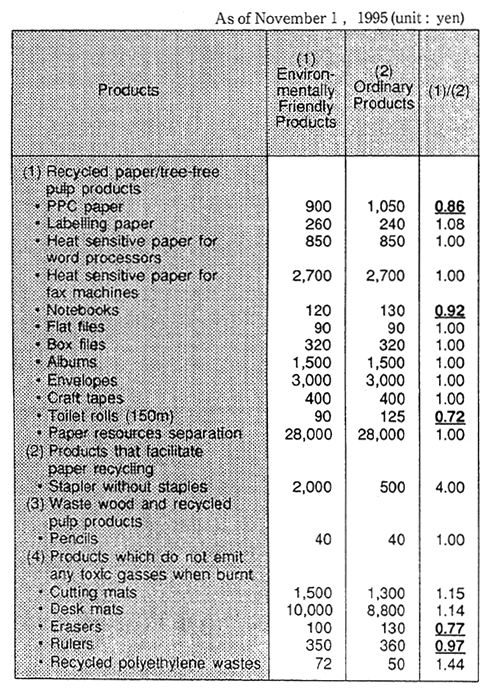
Source: Shiga Prefecture
Table 2-4 Examples of Joint Efforts by Local Industries and Local Governments
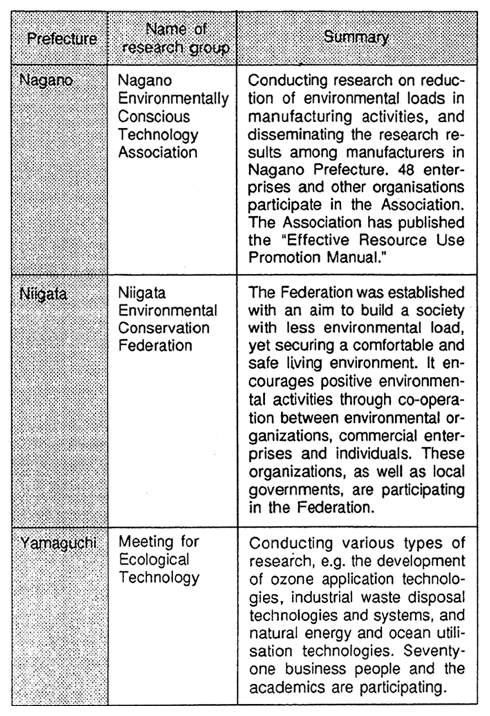
Source: Environment Agency
6. Local Government Measures in Economic Activities
Efforts to make regional economic activities more environmen-tally conscious are spreading to different regions. For instance, Kawasaki City has realised the reduction of both costs and environ-mental load by transporting wastes by railways. In addition, efforts by people in local industries are also spreading.
Furthermore, the Green Purchasing Network has been estab-lished with the aim of stimulating demand for products manufactured with less pressure on the environment. The network involves various elements of society, and promotes enterprises and local governments who give consideration to the environment when choosing products.
7. Measures at the Household Consumption Level
Although it is important for commercial enterprises that provide products to the public to make an effort towards eco-efficiency, in order to build a sustainable socio-economy it is also important for households, as consumers, to increase their own eco-efficiency and for ordinary citi-zens to make environmentally-friendly changes to their lifestyles.
One way for consumers to achieve a lifestyle with less environ-mental load is to use the "environmental housekeeping book." The envi-ronmental housekeeping book provides information about the environ-mental impact of daily activities and provides examples of measures to reduce environmental load. The book is also useful when it comes to un-derstanding how much the environmental load has been reduced and how much one spends on unnecessary and non-urgent items. As a re-sult the reader can objectively evaluate the various efforts he or she has made. The book plays the same sort of role as corporate environmental management.
Table 2-5 Examples of Environmental Housekeeping Books
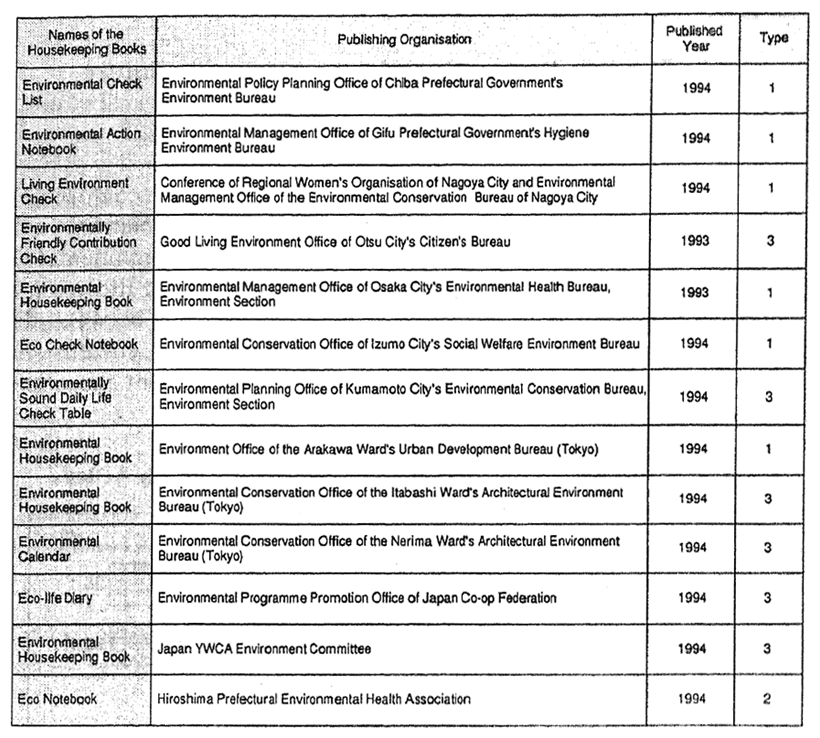
Notes: Three housekeeping book types
(1) This category establishes the norm for consumer action and asks for their implemcntation.
(2) This category tries to encourage actions, which are also goals, by asking people to enter figures and data in the book.
(3) An intermediate type that adopts elements from both (1) and (2).
Source : Environment Agency
Chapter 3. A Sustainable Future Built by Partnerships
Section 1. Building Partnerships for a Sustainable Future
1. Partnerships
Modern economic society has become so big and complicated that connections between human activities and the environment have become hard to understand. In this situation, both the environmental ef-forts and the achievements of individuals tend to be small. However, it is possible to yield major results by forming partnerships between dif-ferent elements of society such as commercial enterprises, citizens and governments. In partnerships, each sector can complement the other. cooperating, dividing roles and joining together.
Fig. 3-1 Reasons for Not Taking Environmentally Friendly Actions
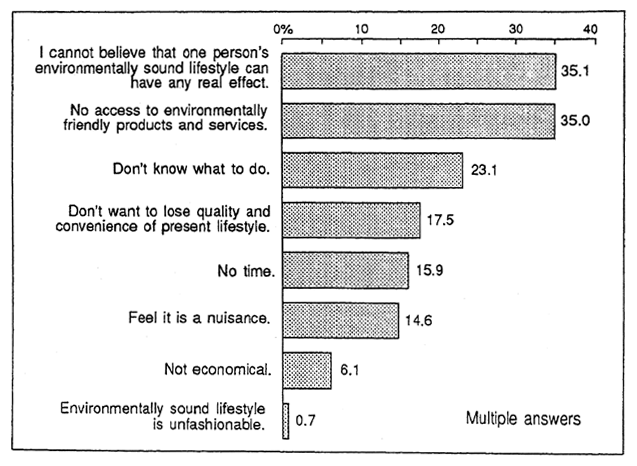
Source NLI Research Institute"Eco life Survey on Urban Residents" (1993)
2. Partnerships to Conserve Regional Environments
In order to conserve regional environments, it is necessary for the different sectors that make up the population of that region to share understanding of the local situation and also to share the work that needs to be done.
Mishima City in Shizuoka Prefecture has a beautiful wetland en-vironment with spring water issuing forth from Mt. Fuji. With the aim of conserving spring water and the rich local environment, the city has been developing a wide range of activities, learning from methods used by the Groundwork Trust movement in the United Kingdom. The Groundwork Trust aims to improve regional environments, making them into something very attractive and something to which people can feel attached. This can be achieved, for example, by creating small parks where people can interact with nature. This should be done by lo-cal residents, using their own wisdom and energy, with cooperation among NGOs, with the participation of local governments and enter-prises, and the whole effort assisted by experts. It is also up to the peo-ple in the region to maintain and manage their environment.
3. Trans-regional Partnerships
Some environments, such as rivers, for example, are trans-regional in nature. In order to conserve transregional environments, it is neccssary for different sectors in different regions to work together on conservation.
The Yahagi River has in its basin 27 cities, towns and villages in Aichi, Gifu and Nagano Prefectures. In order to maintain the river s water quality, a confcrence has been farmed by agricultural and fishery organisations in the lower reaches of the Yahagi River. The conference, with joint efforts being made by local governments and enterprises, has made substantial gains in cleaning effluent from factories and in giving guidance to land reclamation projects. Local authorities in the basin ar-eas are promoting exchanges between residents of the upper and lower reaches, and are also working to ensure joint management of forests in the riverhead area.
4. Trans-industrial Partnerships
To promote corporate measures to reduce environmental load derived from business activities, it is necessary for related industries to join forces, under a fair division of roles, to reduce pressure on the envi-ronment collectively.
Fig. 3-2 Roles of Major Concerned Parties Regarding Introduction of Solar Powered Batteries Used for Vending Machines
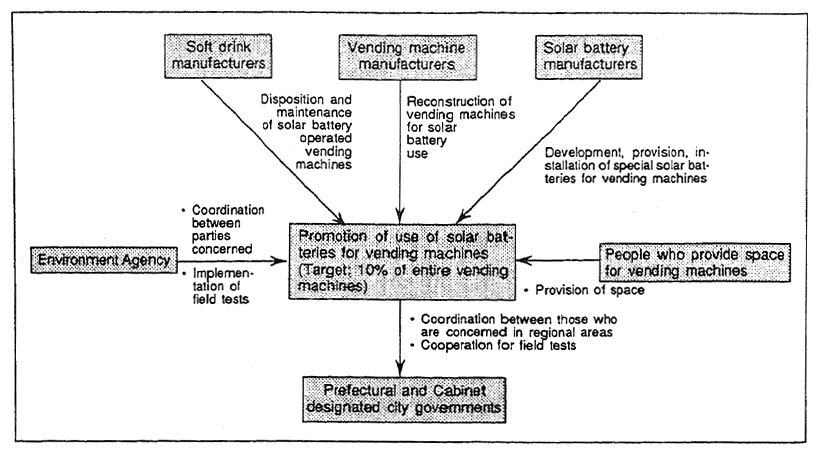
One good example of this joint effort is served in the case of solar power-operated batteries. In order to reduce costs by mass-production, it is necessary to create a certain amount of initial demand for the prod-uct. In order to create this demand, soft drink manufacturers, solar bat-tery manufacturers and vending machine manufacturers have agreed that solar batteries will be used for approximately 10% of soft drink vending machines.
5. Trans-national Partnerships
Some local governments are employing measures that not only offer regional benefits but which also lead to benefits for the global envi-ronment as a whole.
Kitakyushu City, which has overcome severe pollution in the past during its period of fast economic growth, is now working on the environmental cooperation model programme with Dalian City in China, in order to make the most of technologies and experience accumulated by Kitakyushu's officials and citizens.
Also, Shiga Prefecture, which contains Lake Biwa, hosted the In-ternational Conference on the Conservation and Management of Lakes in 1984, with the participation of researchers, government officials and citizens working in the field of lake conservation. The Prefecture has been continuing its efforts to engender international co-operation on lake conservation, and has taken the measure of establishing the Inter-national Lakes Environment Committee Foundation.
In 1990, the International Council for Local Environment Initiatives was established, with the joint efforts and participation of local govern-ments. The Conference is leading the Cities for Climate Protection Cam-paign which aims to draw up and execute action plans intended to re-duce emissions of greenhouse gasses.
6. Environmental NGOs that Link Different Sectors
In Japan, there are 4,506 environmental NGOs. However, more than half of the NGOs have less than 10 staff and have an annual budget size of less than 50 million yen. Public awareness of environmental is-sues is still low in Japan. Although many people consider the activities of environmental NGOs meaningful, considering the activities meaning-ful has not necessarily led to these individuals actually taking any action.
Fig. 3-3 Staff and Budget Sizes of EnvironinentaI NGOs
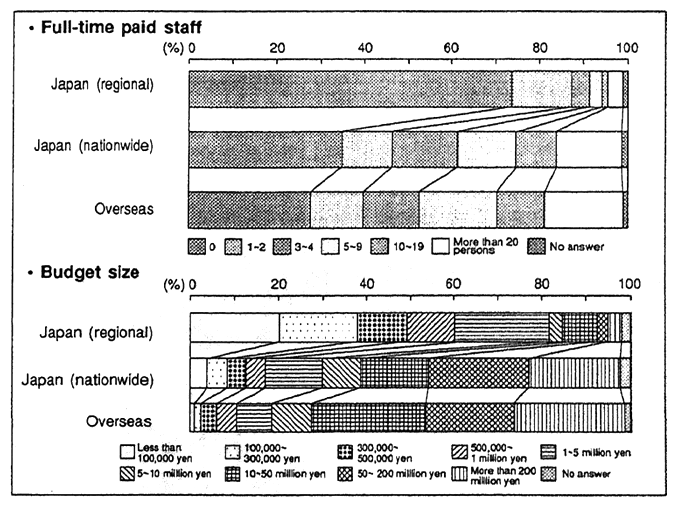
Source: Compiled by the Environment Agency from the "Survey on Admit 4-stration of Environmenal NGOs" by the Japan Environment Association
Napoleon Fish

Photo : Courtesy of Yoji Ogata
Komazawa Field Play Park in Setagaya Ward in Tokyo

Photo : Courtesy of Setagaya Play Park Committee
An Example of Earthwork
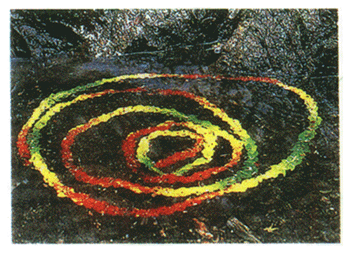
Line to follow colours in leaves turning in the pool at the foot of a waterfall Ouchiyama-mura, 20 November 1991, Andy Goldsworthy
A Wall Painting of the Dunhang Mogao Grottoes (The 158 Grotto. 8th century)

Photo: Courtesy of Tokyo National Rcsearch Institute of Cultural Propcrties
A Stone Statue of the Herten Castle Wall in Germany (Photo on left taken in 1908, photo on right taken recently)

Photo : Courtesy of the Swedish Ministry of Environment and Hiroynki Ishi
Diverse Fauna and Fiora Thriving in the Yathuda Biotope
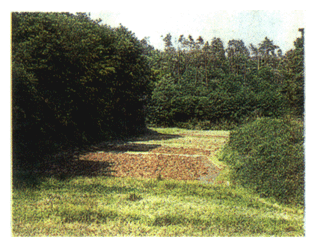
Photo : Courtesy of Ecosystem Conser-vation Society Japan
Reed Colony on the Shore of Lake Biwa

Photo : Courtesy of Shiga Prefectore
Regional Shapes and Colour Difference of a Species

Different sfapes and colours of Damaster Blaptoldes are found in deffer-ent region Regional natures are distinct, therefore regional approaches to wildlife conservation are necessary.
The Mishima Groundwork Committee at Work

Photo : Courtesy of the Japan Ground-work Association
Children Playing in a Stream Created by Concerned Citizen (Koura-cho,Shiga Pretecture)
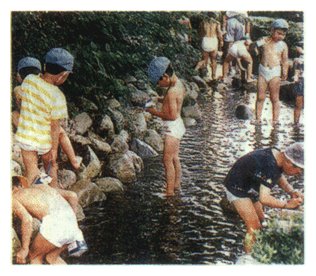
Photo : Courtesy of the Japan Ground-work Association
Classification of Vegetation Zones in Japan (Number shows percentages.)
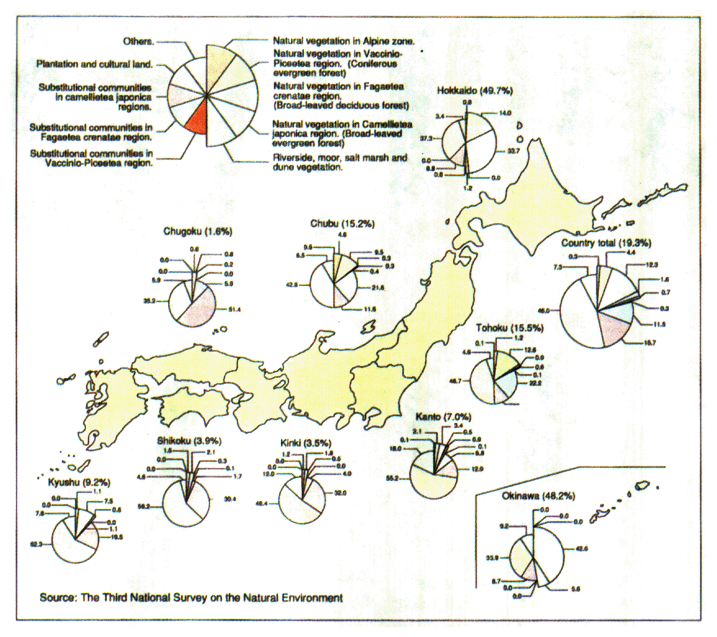
An Activity of the Junior Eco Club
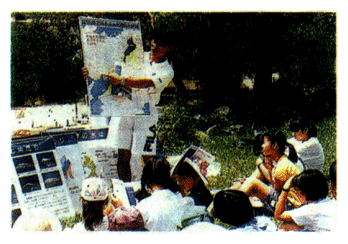
Photo: Courtesy of the Otsu, Nishi-nomiya and Yao City Joint Jun-ior Eco Club
An Activity of the Junior Eco Club
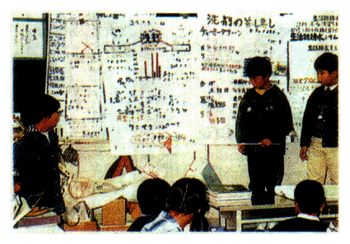
Photo: Courtesy of Ina Elemantary School, Ina City, Nagano Pre-fecture
Ozone Concentration Map
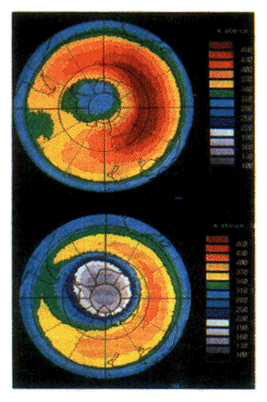
Golden Eagle

Photo: Courtesy of the Society for Re-search of the Golden Eagle
The Comprehensive Program to Improve Base Towns In Nature Park (Green Diamond Plan)
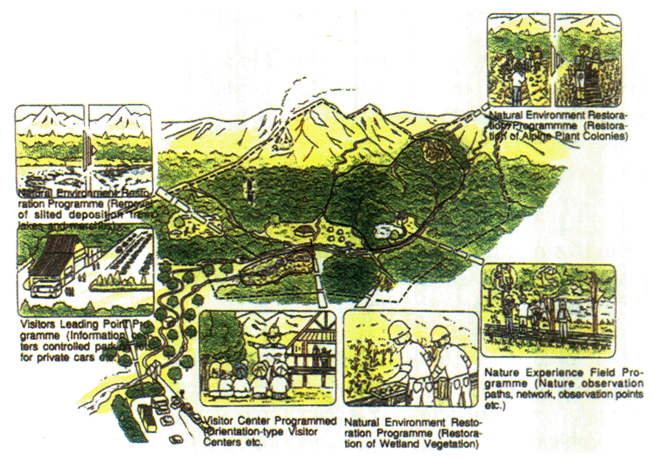
Source: Environment Ageacy
Within international society, however, an NGO conference was held as a part of the 1972 United Nations Conference on the Human Environment, and in the 1992 Earth Summit, the opinions of NGOs were reflected even in the preparation stage of the conference, as well as during the actual conference-where NGOs were officially represented and held the right to state their opinions. NGOs in international society are gaining an important and prominent position.
NGOs are supported by the sympathy of people as individual concerned human beings, NGOs therefore have the power to join vari-ous types of people together for the same cause. It is expected that NGOs have the capacity to connect people from different positions in so-ciety and thereby form useful partnerships for environmental conserva-tion.
7. Significance of Partnerships
To tackle problems that concern many people and sectors, shar-ing information and understanding on issues among those who are con-cerned makes it possible to come up with solutions acceptable to people in different positions. Moreover, by participating in the negotiation proc-ess, people can accept solutions as their own and willingly act upon them. It is also possible to increase the capacity to respond to problems as they arise by utilising those resources that have been accumulated by individuals or groups who have been trying to resolve similar prob-lems.
Examples of environmental conservation activities involving partnerships prove the importance of sharing understanding of prob-lems, devising solutions, and interacting with each participating sector at every stage of executing the measures necessary to solve the prob-lems.
8. Environmental Education and Learning, Establishing Information Base, and Promotion Base for Environmental Activities
In order for each sector to build partnerships and to execute ap-propriate measures, it is necessary to have a system which enables peo-ple to notice the problems that occur in our daily lives, to understand these problems, including their relationships with society and the econ-omy, and to join forces with the efforts made by others to solve the problems.
Fig. 3-4 People's Attitudes towards the Activities of Environmental NGOs
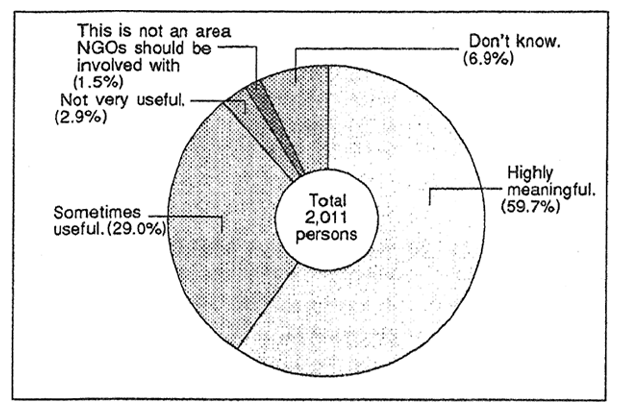
Fig. 3-5 Participation in NGO Activities (Asked to those who answered either "Highly Don't know. Already
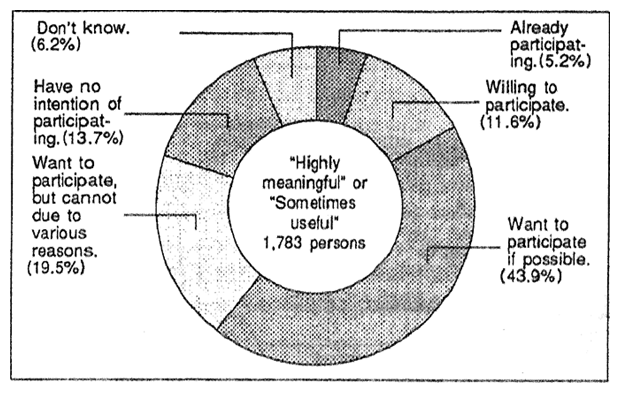
Source : Opinion Poll on Environmental Conservation and People's Lives (January 1995)
Environmental education and learning is aiming to nurture peo-ple who can takc environmcntal consideration into their own lives in the form of practical actions. In June 1995, the, Junior Eco Club was estab-lished to promote environmcntal awareness and understanding among chldren Who will be the leaders of the nexti generation. It also aims to support voluntatry conservation activities by children.
In March 1996, the Environment Agency began employing an en-vironmental information dissemination system. It also began to offer in-formation and learning opportunities to the general public. The Envi-ronment Agency is also investigating the means of establishing a base to promote environmental partnerships, which provides citizens with information and learning opportunities and supports voluntary studies and practical action.
9. Citizens' Participation in Decision Making that Affects the Environment
In order to solve today's environmental problems, it is necessary for citizens, as one sector that is responsible for these problems, to think and learn about the environment, and to take part in decision making, and to engage in practical actions.
In Obihiro City in Hokkaido, the Obihiro Forest plan has been carried out by citizens since 1975. This plan involves surrounding the city centre with a green belt. The planning committee, with the participation of citizens' groups, has been talking with different sectors in the area, and has maintained a healthy 'forest. There have also been discus-sions with citizens to talk about forest management including selective logging and the cutting of lower branches.
Fig 3-6 Forests in Obihiro
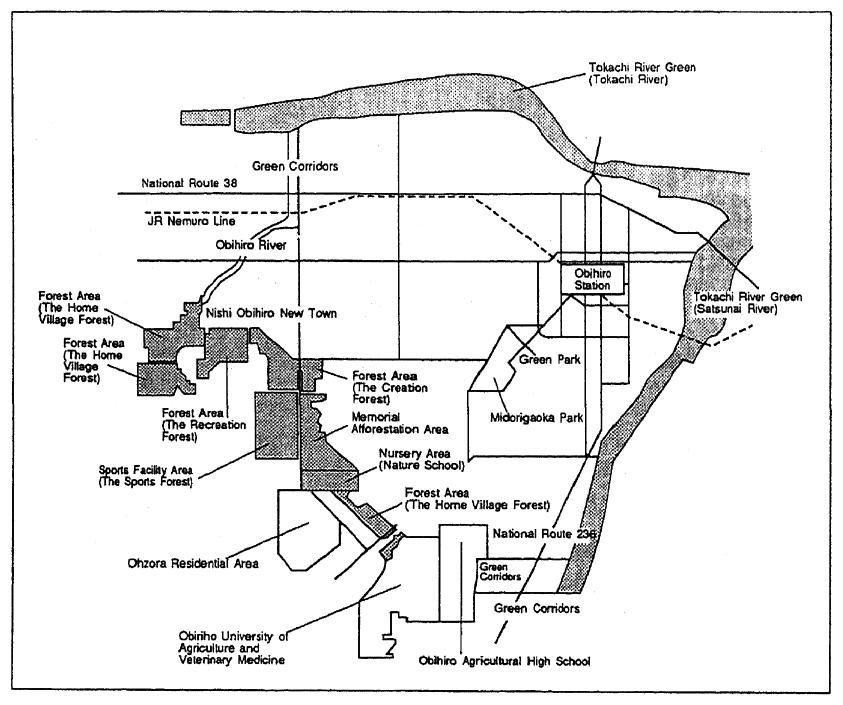
The Natina1 Government listened to the opinions of citizens from different backgrounds in the process of creating the Basic Envi-ronment Plan. it is also seeking the opinions of people from many differ-ent walks of lives regarding how the Plan has been executed and is pro-gressing.
Section 2. The Concept of Environmental Indicators and Environmental Risk : For a Wide Range of Measures with the Better Understanding of Relationships between Human Activities and the Environment
1. Roles of Environmental Indicators
To tackle environmental problems, it is essential that all the par-ties comprising society understand the relationship that exists between human activities and the natural environment. From this Linderstanding they can then devise comprehensive measures to address environ-mental problems in co-ope ration with one another. Environmental mdi-cators illustrate the state of the environment in a way that people can easily understand. They can also illuminate regional differences and trends. Furthermore, they can help us establish goals and (valuate the achievements of those measures taken to meet these established goals. Environment al indicators, therefore, are important tools to help pro-mote the public's understanding of environmental issues and to encour-age the public to carry out the necessary measures effectively.
2. International Efforts to Develop Environmental Indicators
In order to make various types of environmental information eas-icr to understand, it is necessary to have a conceptual framework within which information can be systematically arranged, and environ-mental indicators devised. The OECD (Organisation for Economic Co-operation and Development) has suggested the P-S-R Framework. This foundation, from which environmental indicators can be developed, is rapidly becoming familiar around the world. P-S-R stands for Pressure on the environment, State of the environment, and social Response. The P-S-R framework attempts to indicate the relationship that exists be-tween human activities and the natural environment.
Fig. 3-7 Pressure-State-ResponSe Framework
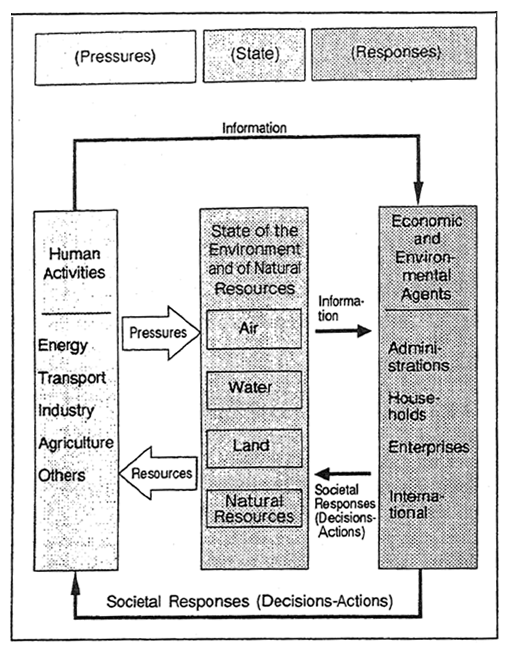
Source OECD Environmental Data 1995
One key way of ensuring that environmental indicators are gen-erally comprehensible is to integrate various specific indicators into a small number of indicators. In the Netherlands, indicators have been de-vised for each environmental issue, such as, for example, climate change. This is part of the National Environmental Policy Plan. The Dutch Gov-eminent subsequently processes the indicators and utilises the data and achievements to help evaluate the progress of the National Environ-mental Policy Plan.
In Germany, an indicator that involves the Total Material Input is being suggested. This illustrates the physical weight of all the re-sources that are put into economic activities.
In Japan, a material balance is calculated each year in the White Paper. Moreover, Japan is experimenting with the UN recommended Integrated Environment Economy Account. This account is designed to help us understand the relationship that exists between the natural en-vironment and the economy in monetary terms.
Fig. 3-8 Environmental Indicators and the Composite Pollution Index in the Netherlands
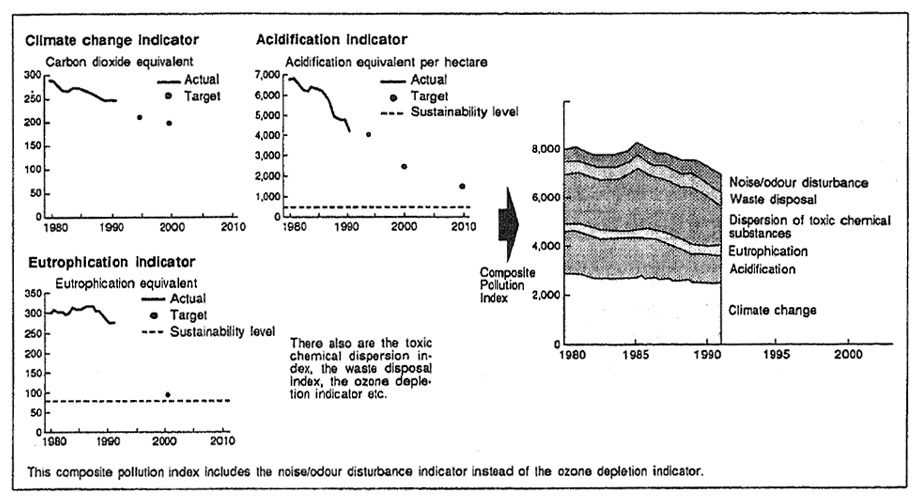
Source World Resources Institutc (WRI): Environmental Indicators (1995)
3. Japan's Efforts
Since the 1960s, environmental standards have been used as indica-tors of pollution in Japan. In addition, after local governments began to establish and implement regional environmental management plans in the 1980s, various comprehensive indicators have been suggested.
In the Basic Environment Plan, comprehensive indicators have been developed to show progress in achieving the Plan's four long-term goals (Sound Material Cycle, Harmonious Coexistence, Participation and International Activities) and to show the relationships that exist be-tween these goals and the measures taken to realise them. The indica-tors will be utilised in the execution and review of the Basic Environ-ment Plan, and are now being developed with full consideration of trends in environmental indicator development both in Japan and abroad.
Fig. 3-9 Material Balance in Japan
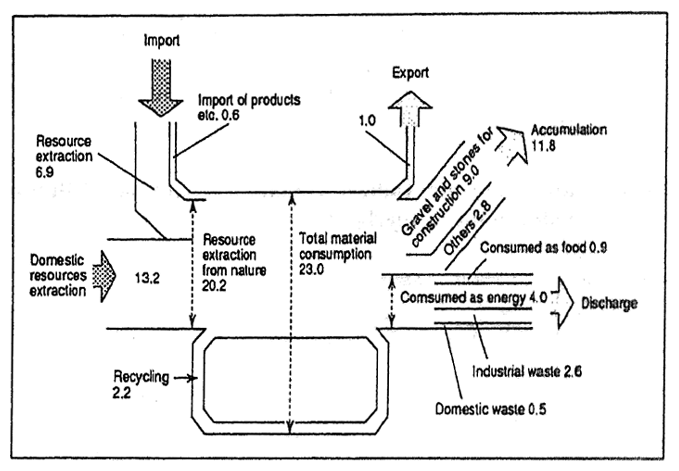
Source Compiled by the Environment Aency from various statistices
4. Towards Further Utilization of Environmental Indicators
The further utilisation of environmental indicators in environ-mental policies is required. It is necessary to establish a coherent sys-tem of environmental indicators depending on the aims and ojbects of the policies. In addition, it is necessary to prepare a foundation to utilis environmental indicators and review that emvorpm,emta; information which is necessary to execute comprehensive environrnmental policies under the guidance of the Basic Environment Law and the Basic Envi-ronment Plan. Moreover, the provision of information using environ-mental indicators should be promoted, and efforts should b made to in-tegrate the environment and the economy by linking enviromental in-dicators to environmenal accounts and other forms ofe nvironment/ economy model.
5. Today's Environmental Policies and the Concept of Environmental Risk
There are, inevitably, elements of uncertainty when trying to as-certain complex causes, results and the probable effects of an environ-mental problem, be it climate change, chemical contamination etc. Given this fact, new paradigms are starting to be used that help decide and execute policies but which also take into account the element of uncer-tainty.
The concept of "risk" in this case is the evaluation of undesirable situation from two perspectives, firstly the "degree of possibility of oc-currence" and, secondly, the "size of impact (if it occurs)." From these two perspectives, appropriate responses to the risk are then devised.
The significance of including the concept of environmental risk in environmental policies is as follows:
a) By scientifically predicting and evaluating the various impacts of those environmental problems which entail uncertainty,"risk" provides a basis on which a policy judgement can be subsequently made.
b) By comparing different environmental risks, a priority order of policies for various causes can be objectively indicated.
c) By applying the concept of environmental risk, it is possible to reduce environmental risks efficiently and systematically, and to link policies regarding different fields such as air and water pollution.
6. Evaluation and Management of Environmental Risk
Evaluation of environmental risk is generally carried out in four stages.
a) Hazard Identification : Evaluation of the toxicity of chemical and other substances.
b) Dose-Response Assessment : Quantitative assessment of the rela-tionship that exists between degrees of exposure to certain substances and impact.
c) Exposure Assessment : Evaluation of actual exposure.
d) Risk Characterization : Clarification of nature and degree of im-pact, talking the above results into consideration. If necessary, also the estimation of the probability of actual occurrence.
Management of environmental risks is a process which includes policy judgement to investigate, evaluate, select and execute measures designed to reduce environmental risks, bearing in mind the results of risk assessment and also taking economic and social situations into con-sideration.
In managing environmental risks, it is necessary to analyse all the stages of an environmental risk's development, from its occurrence to its impact, and to devise countermeasures at every stage. it is also necessary to manage both individual environmental risk and collective environmental risks in a holistic fashion.
7. Risk Communication
In order to reduce environmental risks, it is esscntial that gov-ernments, citizens, commercial enterprises and researchers all have adequate knowledge regarding environmental risks and arc able to work together exchanging opinions and knowledge. An important thing here is risk communication, which involves sharing date and under-standing about risks through information exchanges between the peo-ple concerned, in order to promote the appropriate actions. To encour-age risk communication, it is important to obtain furthcr undcrstanding on the concept of risk itself which is indicated by degrees of probability. At the same time, information should be made available at ach stage of risk assessment and management. There should be some feedback from the recipients of the information.
8. New Trends Regarding Environmental Risk Concerning Chemical Substances
In the U.S.A. and Europe, Pollutant Release and Transfer Regis-ter (PRTR) is employed in order to implement comprehensive environ-mental risk measures. The system requires commercial enterpriscs with chemical manufacturing plants to regularly regisecr the amount of emissions generated by their activities with the government. This has proved to be very effective in promoting emissions control on a volun-tary basis and has also helped governments devise relevant policies. The OECD meeting of environment ministers in February 1996, recom-mended the introduction of PRTR to all member states.
In Japan, local governments are in the process of establishing chemical substance management guidelines in order to comprehen-sively secure the safety of chemical substances in their local areas. Ad-ditionally, the approach known as responsible care," which entails com-mercial enterprises devising consistent environmental measures on a voluntary basis is being practised in the international community. Its practical development is urged generally. Moreover, in January 1996, a midterm report of the Government's Central Environment Council was submitted, stating that comprehensive measures should be taken to tackle the problem of toxic air pollutants.
Procedures for respon ding to chemical induced enviromnent a! risks have been established in Western counties. in Japan, some meas-ures have begun to be seen, howevcr, systematic responses are far from satisfactory, which leaves us the task of promoting systematic proce-dures.
Fig. 3-10 Framework of Environmental Risk Measures (Health Hazards Caused by Chemical Suhstances)
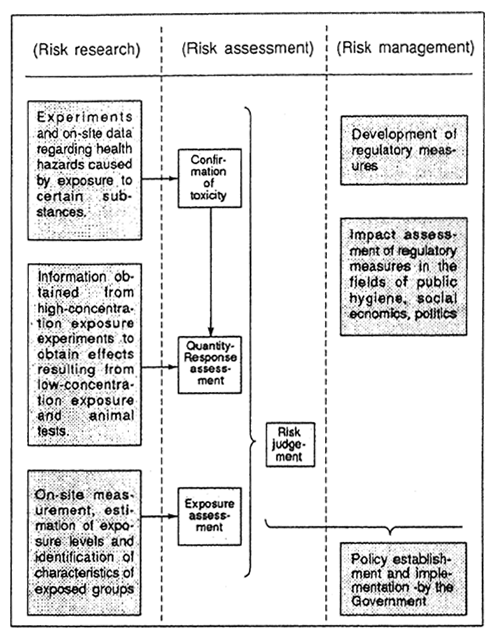
Section 3. To Incorporate Environmental Consideration into a Wide Range of Socio-Economic Activities under a Fair Division of Roles
1. Making Containers and Packaging Recycling a Legal Responsibility under a Fair Division of Roles
In June 1995, the Law for Promotion of Sorted Collection and Re-cycling of Containers and Packaging was enacted. The law was subse-quently enforced in the following December. Given the seriousness of the waste desposal problem in Japan, this law aims to reduce the amount of general wastes produced and also to promote the appropriate use of wastes as recycled resources.
This law stipulates, in principle, that all containers and packaging that come with products, such as bottles, cans, paper, plastics etc., should be carried out sorted collection and recycled. The responsibility for this task is shared between the government, local authorities, con-sumers and businesses. The law promotes the establishment of rules that incorporate environmental concerns into socio-economic activities under a fair division of roles.
2. Economic Instruments
Economic instruments have the ability to promote environ-menally sound actions, dividing the responsibility for such actions fairly between the various members that go to make up our complex, modern society through market mechanism. It is expected that economic instru-ments will be highly effective as a policy measure to solve many current environmental problems that are caused by daily business activities and lifestyles. A variety of practical examples of economic instruments taken to promote environmentally sound actions can be seen in the United States and European countries.
(1) Discussion on Economic Instruments in OECD
A report submitted at the fifth OECD Environment Policy Com-mittee at Ministerial level in February 1996 stated that creative use of taxation systems for the environment can offer an opportunity to inte-grate environmental policies with economic policies. The report also recommended that more analysis should be undertaken into examining ways in which government subsidies can affecet the environment. Moreover, in the report published in January 1996 by the joint committee of the OECD Committee on Fiscal Affairs and the Environ-meat Policy Committee, a strategy was drawn up, designed to promote the further utilisation of economic instruments to promote environ-mental protection among OECD countries.
Fig. 3-11 Conceptual Frame work of the I aw for Promotion of
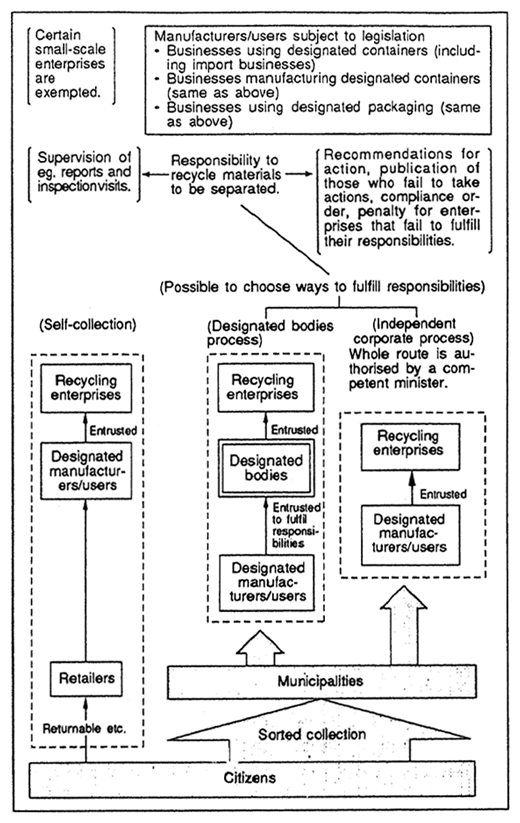
(2) Utilisation of Economic Instruments in Different Countries
In the Netherlands, charge systems were abolished in July 1992, and a new energy tax was introduced. This involves establishing the en-vironmental tax due per company according to the amounit of carbon emissions and energy used by that company. Since January 1, 1996,, the Small-Scale Energy Consumption Tax has been in effect, Following the government's policy that shifts taxation article fromincome to environ-mental use, the tax revenue is put back into the economy to create jobs and to maintain purchasing power.
In Denmark, environmental taxes have been introduced regard-ing CO2 emissions, use of electricity, coal, containers, and waste. disposal. In 1995, taxes on NiCd batteries, organic solvents and inseticides were introduced for the first time. Moreover, in order to reduce the gap be-tween the tax amount borne by households and industries, the 1995 re-vision decided to gradually increase th energy tax for industries until the year 2000.
In the United States, economic instruments are also used at the local level. The most common form of environmental taxation is the taxation of polluting enterprises. The revenue is subsequently used to fund clean-up operations and other environmental activities. There are also cases where tax systems are used as an incentive to foster the de-velopment of clean technologies.
(3) Citizens' Understanding on Economic Instruments
In 1995, the Environment Agency conducted a survey on the general public's understanding of the economic instruments which are expected to be effective in promoting environmental conservation, The Government is hoping that there will be an increased level of discussion among members of the general public on the role economic instruments can play as a part of overall environmental policies.
Table 3-1 Environmental Taxes and Energy Taxes on Industry in Denmark (Approved in 1995)

Note. I DKK (Danish K) 19 yen (January 1996)
Source Enviroumenta1 Taxes in Denmark 1996, The Danish Envi-ronmenta;l Protection Agency
Fig 3-12 The Development of the Dutch Financing System for the Environmental Policy
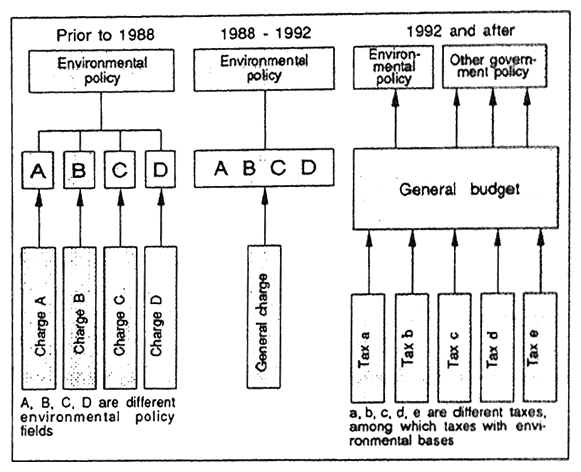
Source environmental taxes VROM/DGM/B/EB/APH oct 4,1995
Table 3-2
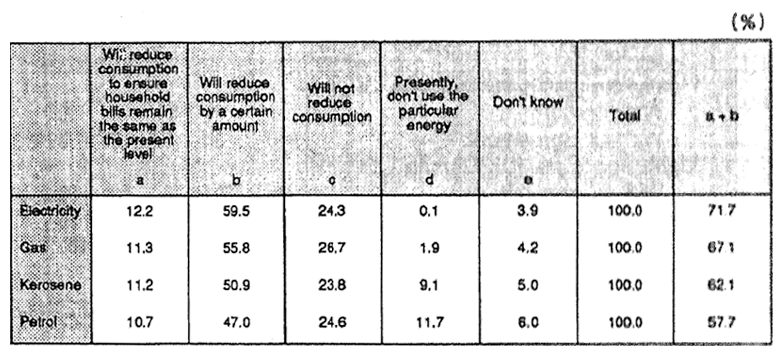
Opinions on the Introduction of Environmental Taxes and Charges

Source: Environment Agency
3. Environmental Impact Assessment (EIA)
(1) Environmental Impact Assessment in Japan
In Japan, a system of environmental impact assessment (ETA) has been employed that is based on the execution guidelines decided by the Cabinet in 1984. In order to revise the current ETA system, a revi-sion that might also include the possibility of introducing ETA legislation, the Environment Agency has inaugurated the EIA Legislation Study Committee in June 1994. The Committee has been analysing and ad-dressing various matters pertinent to the EIA system.
(2) Consolidation of EIA Systems by Local Governments
At the prefectural and cabinet designated city governments' level, as of December 1995, 50 out of the 59 governments had estab-lished their own ETA systems. These systems generally follow the na-tional system, however each system also has its own local characteris-fics. Some extend ETA coverage to the activities of companies smaller than the minimum size of company stipulated in the ii~ ti0II~d F!. ~ tern. Other regional EIA systems require a Scries of advance dures.
Fig. 3-13 Years of EIA System Establishment in Prefectures and Cabinet Designated Cities
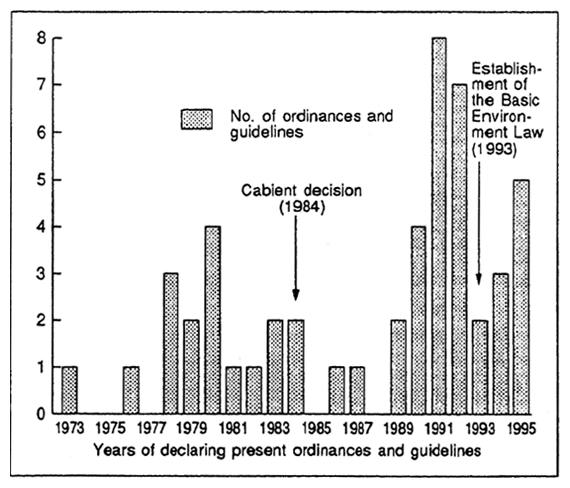
Source Environment Agency
(3) Consolidation of EIA Systems Abroad
According to an Environment Agency survey on EIA systems it 61 countries, an increasing number of nations havc EIA Iegislation. Of the 26 OECD countries, every country, with the exception Japan. had adopted some form of legislation which regulates the general proce dures involved in ETA.
Table 3-3 ETA Systems of the OECD Countries and Their Years of Establishment
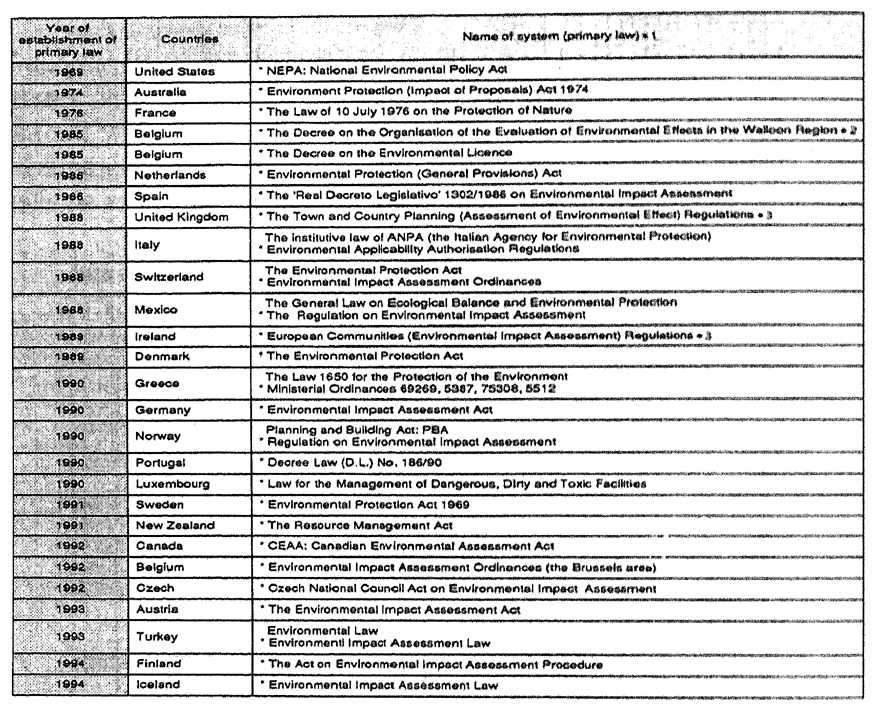
Notes 1. Law providing for specific procedures of EIA.
2. In Belgium, three autonomous regions have their own md ~pend n en ~ir n~
menati administration system. The ordinances of cach region act as regiona1
legislation, and have legel power.
3. It is specified that, in the UK and Ireland, regulations with Iegally binding
power can be established on the basis of EU Directive.
Source Environment Agency
Section 4. Gathering Human Wisdom for a Sustainable Future
1. Today's Environmental Problems and the Role of Science
In times past, the measures taken in case of pollution were firstly to ascertain that there was a problem, then to investigate and discover the causes, and finally to devise counteractive measures such as emis-sions control. Research achievements in the field of Natural Science were gathered together to help us measure the environment, discover the causes of pollution, devise technologies to dispose of pollutants and support solutions of problems.
Today's environmental problems, however, are the result of a highly complex web of natural and social factors and have grown to such a proportion that they threaten the limited environmental carry-ing capacity of the Earth. Given this development in the scale and na-ture of environmental problems, it is necessary to develop a new eco-nomic and social system, and this can be done by understanding the re-lationship that exists between human beings and the natural environ-ment. Environmental problems should be viewed holistically and envi-ronmental pressures should be reduced taking a long-term view. This new system will allow both present and future generations the opportu-nity of really raising their quality of life.
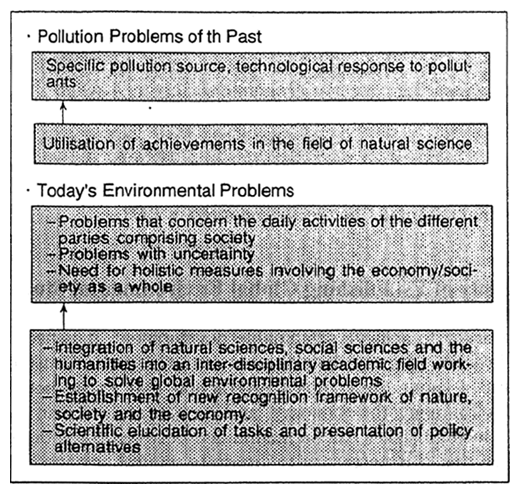
2. Depletion of Ozone Layer, Global Warming and Science
Now, let us look at the wide range of roles that science is playing regarding the issue of depletion of ozone layer.
Since the possibility of depletion of ozone layer caused by CFCs was first published as a theory in 1974, efforts have been made in parts of the world to check the production of CFCs, to measure the density of CFCs and to discover the mechanisms that lie behind depletion of ozone layer. The control of CFCs, however, proved difficult, partially because of the usefulness of CFCs and partially because of increased CFC use in developing countries.
The discovery of the hole in the ozone layer which occurred in 1985 served to increase scientific recognition of the seriousness of deple-tion of ozone layer and prompted international debate and negotiation regarding CFC production and consumption control. This process of de-bate and negotiation, leading from the scientific research, resulted in the adoption of the 1987 Montreal Protocol.
The Montreal Protocol set an important example. It was an inter-national agreement that sought scientific explanations of a global envi-ronmental issue that concerns economic society as a whole. In the case of the global warming issue, the Inter-governmental Panel on Climate Change (IPCC), which was established in 1988, and researchers from other organisations, have been working on a scientific explanation of the problem. Based on the IPCC report, the United Nations Framework Convention on Climate Change was adopted in 1992.
3. Necessity of Establishing Global Environmental Studies
In order to achieve sustainable development, it is necessary to set the direction of social development onto the path of sustainability, taking into account the complex interaction that exists between the natual environment, the economy, and human society, and exploring ways in which a balance can be maintained between these three forces. To achieve this, it is necessary to integrate natural sciences, social sci-ences and the humanities in order to solve global environmental prob-lems holistically, rather than by dealing with individual problems in separate, specialised academic fields. This has also been suggested in the Science Council.
Through the establishment of the discipline of Global Environ-mental Studies, it is expected that the new natural, social and economic paradigms necessary to support a sustainable society will be estab-lished and that scientific explanation and policy choices for each prob-lem can be indicated.
Fig. 3-14 Interdependency of Environmental, Economic and Social Considerations
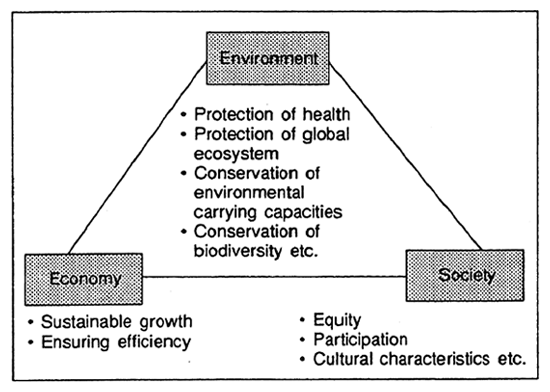
Source: Compiled by the Environment Agency from "Sustainabiity and the Wealth of Nations" (Ismail Serageldin, 1995) by the World Bank
Chapter 4. State of the Environment
Environmental issues in the past were mainly severe pollution cases and instances where nature was destroyed. Such cases were caused by specific social and economic activities in particular areas. By contrast, in recent years, ordinary corporate activities and people's daily activities are increasing pressure on the environment and this can lead to global environmental problems, or problems that will be passed down to future generations.
In addition, regional pollution, which was thought to be getting better, has worsened in the last few years. Furthermore, some problems that were not fully understood in earlier times, are becoming clearer.
1. Global Warming
Global warming is a phenomenon which causes the average global temperature to rise due to the accumulation of increased atmos-pheric concentrations of greenhouse gases, such as emitted CO2. The in-crease in the quantity of greenhouse gases comes as a result of our in-creased consumption of fossil fuel. Global warming causes climate changes and a rise in sea level, and it is feared that the phenomenon will have major implications not only for human beings but also for wildlife and the global ecosystem.
Fig. 4-1 Changes in CO2 Concentration at Mt. Mauna Loa, the South Pole and Ryori
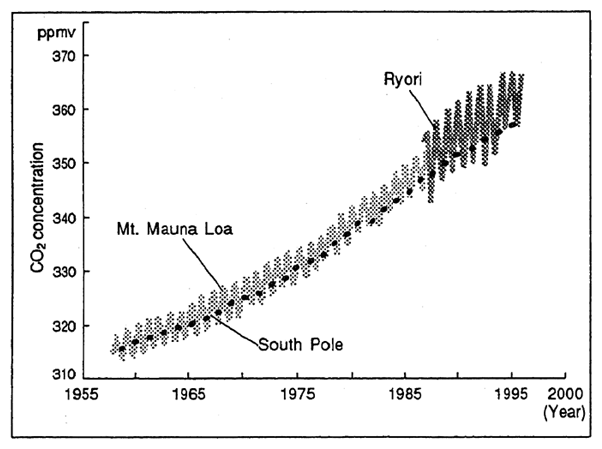
Source : Mateorological Agency
Atmospheric concentrations of CO2 in the period prior to the in-dustrial revolution were around 280 parts per million (ppm). However, this figure has continued to rise as the world's population increases in size and industries develop. According to data from Iwate Prefecture (Ryori), the average CO2 concentration in 1996 in the prefecture was 363.4 ppm.
The world's CO2 emissions (deriving from fossil fuel consumption and cement production) in 1992 amounted to 6.1 billions tonnes in car-bon. This figure is about four times as much as that for 1950. In recent years, an increase in emissions from developing countries is particularly noticeable.
Japan' s total CO2 emissions in 1993 amounted to 324 million tonnes in carbon. This figure was down slightly from that of the previous year due to a cool summer and the slow growth in energy demands that re-sulted from the economic recession. However, it is estimated from pre-liminary reports that the level of emissions in 1994 would exceed 340 million tonnes in carbon.
Fig. 4-2 Trends in CO2 Emission in Japan
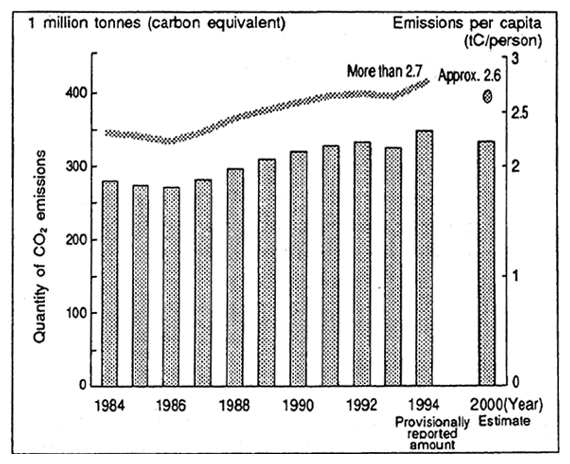
Source: Environment Agency
Fig. 4-3 Changes in the World's CO2 EmissiQn
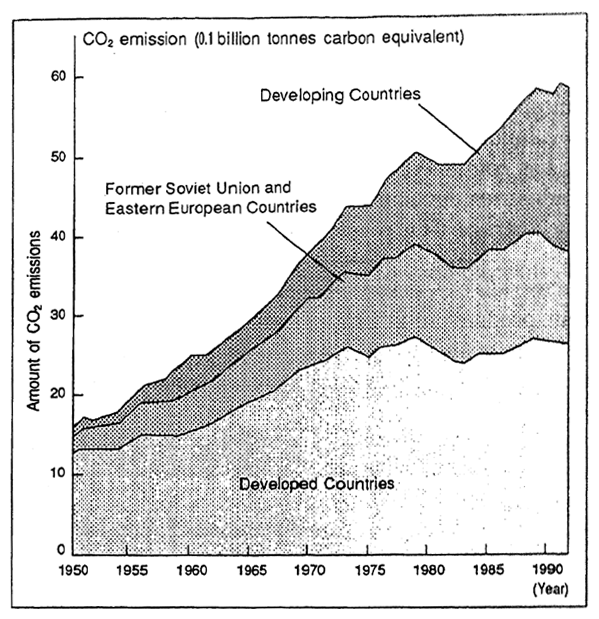
Source Drawn up, using estimates by the Carbon Dioxide Information Analysis Center, Oak Ridge National Laboratory
The second evaluation report of the IPCC, in 1995, announced that a significant amount of evidence existed to show that global warm--ing is starting. It is estimated that if no countermeasures are taken. by the year 2100, the average temperature of the Earth's surfac. will have risen by about 2 degrees Celsius. The sea level will have risen by an av-erage of 50cm.
Given this situation, in March 1994, the Framework Convention on Climate Change was enforced. Domestically, various measures are being taken, along with the Action Programme to Arrest Global Warm-ing that was established in October 1991.
2. Ozone Layer Depletion
The ozone layer is located in the lower part of the stratosphere, and if it is destroyed by substances such as CFCs, the amount of ultra-violet rays reaching the surface of our planet will increase. It is feared that this will seriously affect human beings and our ecosystem as a whole.
In Antarctica, ozone has been depleted every spring since the end of the 1970 s, and this phenomenon has become known as the ozone hole". 1995 saw the biggest hole in the ozone cover yet, making 1995 the fourth consecutive year that the ozone hole was the largest ever recorded.
The serious situation of recent ozone depletion has promoted dif-ferent international measures such as CFC production control and the phased enforcement of regulations restricting CFC use following the signing of the Montreal Protocol. Additionally, the promotion of CFC collection, recycling and destruction has been put onto the agenda.
3. Acid Rain
Acid rain is rain with high levels of acidity and is created when rainwater mixes with sulphuric acid and nitric acid transformed from air pollutants such as sulphur oxides and nitrogen oxides. It is feared that acid rain will acidfy lakes, marshes and rivers, doing harm to fish and other forms of wildlife. It is also feared that acid rain will acidify soil, exerting a negative influence on woodlands.
Although European-levels of acid rain have been recorded in large areas of Japan, there has not yet been any clear impact on Japa-nese ecosystems.
In order to implement effective acid rain countermeasures, due to the problems trans-regional character, international co-operation is indispensable. In particular, economic development in the East Asian re-gion has been resulting in increasing levels of sulphuroxide and nitro-gen oxides emissions. Acid rain in the area might lead to a serious envi-ronmental problem, therefore, further international co-operation through groups such as the East Asia Acid Rain Monitoring Network is necessary.
4. Air Pollution Caused by Nitrogen Oxides
In Japan, the concentration of sulphur dioxide and carbon monox-ide in the air falls within acceptable limits. However, when it comes to nitrogen dioxides and suspended particulate matter, achievement rates of the Environmental Quality Standards have been low. Nitrogen diox-ide, when its concentration in the air is high, has undesirable effects on the respiratory organs. As a nitrogen oxide such as nitrogen monoxide, it is also a cause of acid rain and photochemical pollution. Therefore fur-ther measures have to be promoted to counter this problem.
Suspended particulate matter is composed of very fine sub-stances, under 10 microns in diameter, which float suspended in the air. Due to their very small size, these tiny particles remain in the air for a long time and consequently affect people's respiratory organs. Corpus-cles in diesel smoke, in particular, are suspected as playing a contribut-ing role in the development of cancer, asthma and hay fever. Various in-vestigations and research programmes have been conducted on this matter.
Fig. 4-4 Acid Rain in Japan (The Second Survey for Acid Rain Measures)
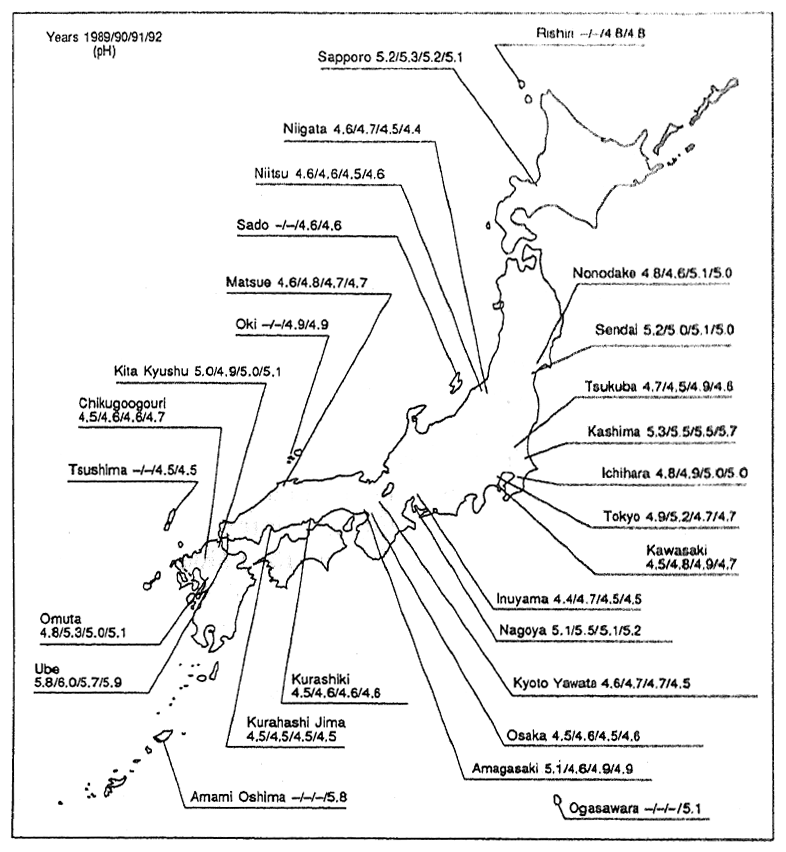
Source: Environment Agency
Fig 4-5 Changes in Anuual Average NO2 Concentration (Average of Continuously Monitoring Stations)
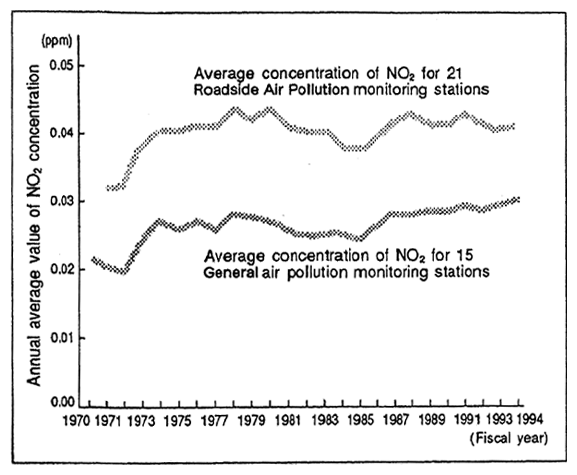
Source : Environment Agency
5.Noise,Vibration and Offensive Odour
Problems such as noise , vibration and offensive odour are intimately connected with the senses of the general public , Solving these problems is an important task in order to protect our immediate living environment. Although the number of complaints made for each cate-gory of problem is decreasing every year, they still hold a major share in the total number of pollution related complaints made to authorities. The causes for this category of complaint are becoming more diversi-fied.
Fig. 4-6 Changes in Number of Grievances in Typical Case
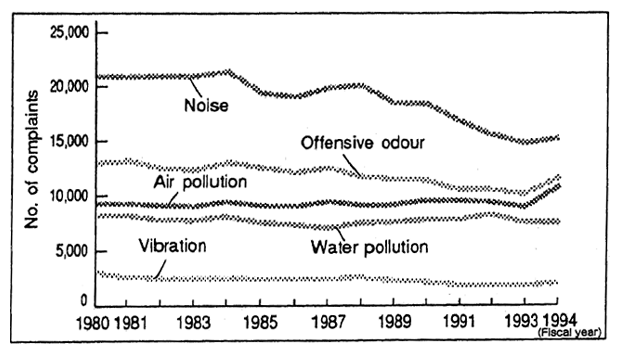
Source: Environment Dispute Coordination Commission
6. Water Pollution in Oceans, Rivers and Lakes
Regarding the state of water pollution in Japan, the criteria laid out in the Environmental Quality Standards are mostly satisfied con-cerning those toxic substances that are actually included in the Envi-ronmental Quality Standards system. However, as much as 30% of oceans, rivers and lakes fail to meet the criteria laid out in the Environ-mental Quality Standards when it comes to the problem of organic con-tamination.
In closed aquatic environments such as lakes, inner sea areas and inner bay areas, pollutants are more likely to accumulate, when makes it more difficult to improve or maintain water quality. In particular, the Environmental Quality Standards achievement rate is low in lake and marsh environments. Worsening eutrophication is causing offensive odours in household water and is having negative repercussions on fish-eries,
Fig. 4-7 Changes in the Achievement Rate of Environmental Quality Standards (BOD or COD)
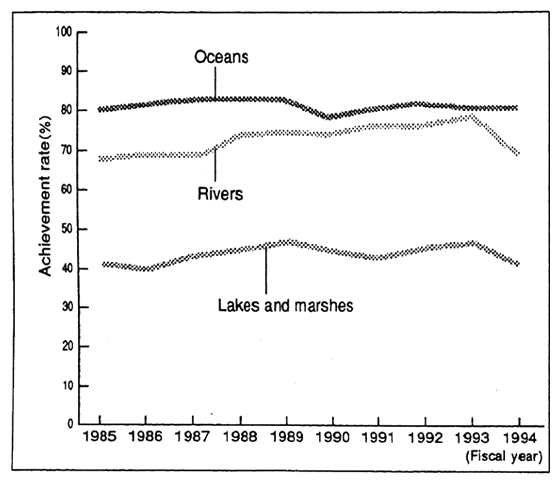
Source Environment Agency
Moreover, an increase in waste water discharge from households has been placing greater environmental load on rivers in urban areas. Measures to counteract the problems resulting from household dis-charge, such as improvements in the sewage system, are being imple-mented.
7. Underground Water
Underground water is a precious fresh water resource. However, since the early 1980s, some underwater reserves have been contami-nated with organic chlorine compounds. The causes for this are consid-ered to be mainly toxic substances, effluent which contains such toxic substances, and inappropriate waste management. In addition, under-ground water contamination by nitrogen is becoming apparent. This is caused by household waste discharge, agricultural wastes from cattle farming and areas of intensive farming that consume large quantities of fertiliser. Inverstigations into this matter are becoming necessary in contaminated areas.
8. Soil Pollution and Land Subsidence
Soil is an element that forms part of the natural environment. In-organic and organic matter, micro-organisms and wildlife all utilise soil in some way or another during their natural cycle of circulation. More-over, soil is essential for human life. It is a foundation for agriculture and an important natural resource. Soil creates underground water reserves, possesses the capacity to retain water and maintain ecosystems.
As for soil on agricultural land, although no new contamination cases have been reported tn recent years, 7,140ha of land has been iden-tified as contaminated, and measures are being implemented to address this problem. Concerning soil in urban areas, a total of 232 contamina-tion cases have been reported since 1975, and the number of cases where the nature of the contamination has been identified has been in-creasing recently.
Regarding land. subsidence, restrictions on underground water pumping have improved the overall situation. However, in some regions, a significant amount of subsidence is still reported due to water pump-ing for agriculture and for melting snow.
9. State of Increasing Wastes and Recycling
In 1992, the total amount of non-industrial waste generated in Ja-pan amounted to 50.22 million tonnes. This figure was 1.1% less than that of 1991 due to the economic recession and improved materials. This was the first decrease recorded in 9 years. However, the problem re-mains that there is still is a shortage of final disposal sites. Securing new sites, especially in the metropolitan area, is becoming a matter of high priority.
In order to improve this situation, regulations regarding waste disposal, recycling and the reuse of resources are an urgent priority. Al-though the recycling of paper, steel cans and aluminium cans is on the increase, recycling rates for general waste as a whole in 1992 remained at only 3.9% of the total general waste generated.
Fig. 4-8 Changes in Total Amount of Waste and Amount of Waste Per Person Per Day
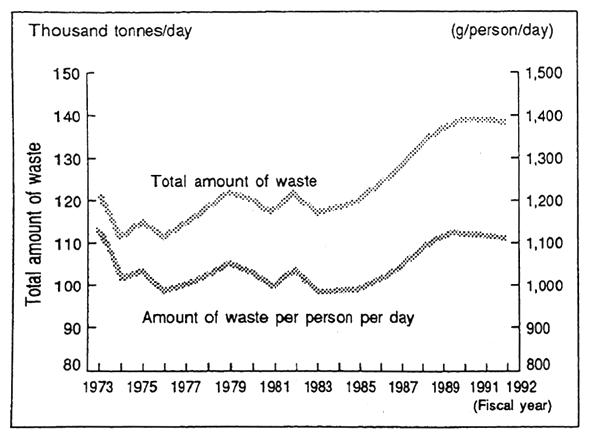
Source The Ministry of Health and Welfare
Fig. 4-9 Changes in Total Industrial Waste Discharge
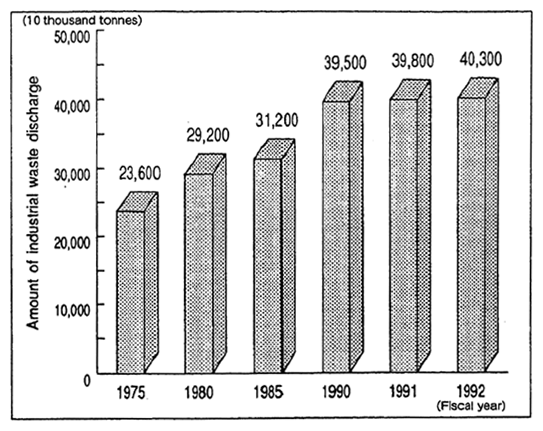
In 1992, the amount of industrial waste amounted to around 403 million tonnes, a one percent increase from the 1991 figure, The rate of increase slowed due to the economic recession. Of all the industrial waste, around 40% is recycled and 22% is disposed of. The life span of the final disposal sites is very short and it is becoming an ever more ur-gent issue to secure new sites for industrial wastes.
10. Japan's Vegetation Cover
Japan has one of the highest percentages of forest cover remain-ing among the world's nations. As much as 67 percent of the entire country is covered with forests and 92.5 percent of the country is cov-ered with some form of vegetation cover. In cities, however, large spaces with no form of vegetation cover are spreading, and natural en-vironments are increasingly confined to limited areas.
Of Japan's naturally forested areas, nearly 60 percent can be found in Hokkaido. The majority of other naturally forested areas are to be found in the mountain regions of Tohoku and Chubu, and also along the Japan sea coast and in Okinawa. In the Kinki, Chugoku and Kyushu regions, naturally forested areas are very small, and are largely rele-gated to the higher regions of mountains, and peninsulas and islands.
Fig. 4-10 Trends in Steel Can Recycling
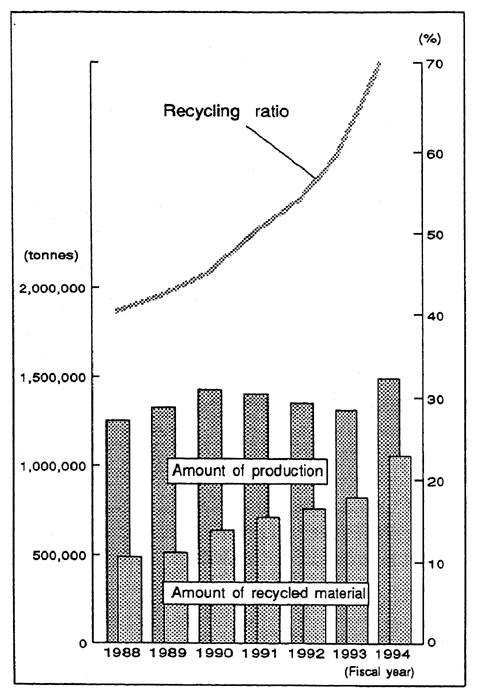
Source : Japan Used Can Treatment Association
11. Disappearing Tropical Forests
Tropical forests play an important role in the maintenance of the global environment, absorbing CO2 and regulating water balance and heat rediation from the earth. Tropical forests also perform the highly important function of maintaining biodiversity. The rapid destruction of tropical forests in recent years not only exhausts forest resources but also undermines biodiversity. Moreover, it is feared that the large quan-tities of C2 emissions resulting from forest destruction might serve to accelerate the process of global warming.
Fig. 4-11 Trends in Aluminium Can Recycling
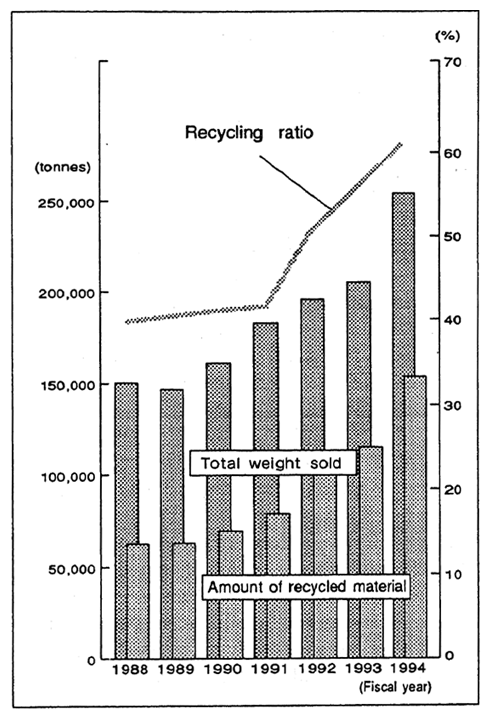
Source : Japan Aluminium Can Recycling Association
Untraditional slash and burn agriculture and excessive logging are often pointed out as being causes of tropical forest destruction. How-ever, behind this phenomenon, there are also social and economic fac-tors such as poverty, the increase in human population and issues of land tenure.
12. Endangered Wildlife
Human beings have historically survived by utilising wildlife re-sources as food, and as materials for tools, clothing etc. These activities, however, sometimes led to over-hunting. Moreover, the growth and spread of human economic and social activities has also contributed to the destruction of wildlife and wildlife habitat.
In Japan, threatened and endangered species are designated as "national endangered species" and measures are being taken to protect them. Presently, 22 extinct animal species and 110 endangered animal species have been officially recognised. As for plant species, it has been reported that 147 are listed as almost extinct and 677 as endangered.
13. Interacting with Nature
In recent years, as people's environmental awareness rises and, at the same time, as natural areas disappear from the urban environ-ment, there is an increasing need on the part of people to interact with nature. Since the late 1980s the number of people visiting nature parks has steadily increased, and in 1994, the number of visits reached 999.87 million.
The total area of nature parks in Japan accounts for 14 percent of Japan's land area if all national parks, quasi-national parks and prefec-tural parks are included in the figure.
In order to reinforce the conservation of these national parks and to improve them for visitors, the Green Diamond Plan (Comprehensive Programme to Improve Base Town in Nature Parks) was established. This plan includes the promotion of nature conservation and restoration, and the establishment of nature study areas equipped with high quality natural history information and guidance facilities for visitors.
14. Heat Island and Artificial Light Pollution
In metropolitan areas, the massive consumption of energy com-bined with the predominance of asphalt ground cover in the form of streets, prevents the drop in night time temperatures that would other-wise be caused by water evaporation. This is called the "heat island" phenomenon.
Furthermore, excessive artificial light levels are a problem in that they eliminate the possibility of observing the beautiful panorama of stars and constellations in the night sky. Excessive artificial light lev-els might also have a negative effect on wildlife ecology.
Moreover, research is conducted to investigate the health hazard posed by electromagnetic waves and the mechanism of hay fever which is induced by cedar trees.
Fig. 4-12 Changes in Tokyo's Average Temperatures
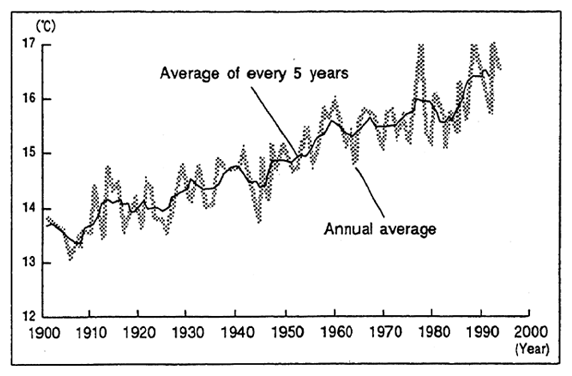
Source Meteorological Agency
15. Citizen's Environment Awareness
In the Basic Environment Plan, citizens are expected to under-stand the relationship that exists between human beings and the envi-ronment, to make efforts to reduce the environmental load resulting from their daily activities, and to voluntarily and actively engage in ac-tivities that will improve their immediate environment However, vari-ous surveys reveal that although many people are becoming more envi-ronmentally aware, when it actually comes to taking concrete actions, such as making environmentally friendly lifestyle changes, only a mod-erate amount of enthusiasm is generated and few positive actions are seen.
16. Encouraging Conservation Action
In order to promote the purchase of more environmentally friendly products manufactured with less environmental load, the eco-mark programme is underway as a part of the government's eco-label-ling programme. The number of products with eco-marks is increasing every year, and by the end of 1995, 66 types of products and 2,105 brands carried these labels.
Fig. 4-13 Is it Possible to Change Over-Consumptive Lifestyles? The ratio of those respondents who said it was possible (or already implementing changes) (Regional)
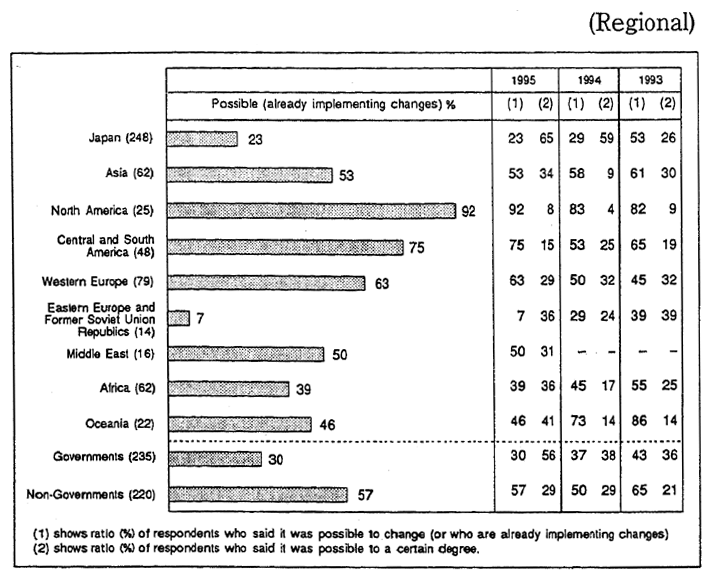
Source The Asahi Glass Foundation "The Fourth Questionnaire on Global Environment and Human Survival"
Fig. 4-14 Trends in Number of Eco-niarked Product Types and Brands
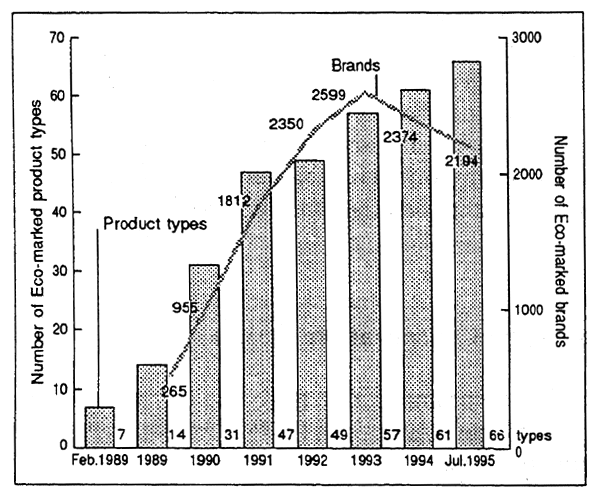
Source Environment Agency
The number of these environmentally friendly products has been steadily increasing, and in February 1996, the Green Purchasing Net-work was established with the co-operation of commercial enterprises, governments, NGOs and academic researchers. The aim of the Green Purchasing Network is the promotion of the purchase and consumption of environmentally friendly products throughout the economy as a whole.
Final Remarks
It has been four years since the nations of the world agreed to pursue the huge task of achieving "sustainable development" at the 1992 Earth Summit. Now it is time to start evaluating the progress that has been made. Given the situation that the world and each nation have various problems, is the challenge to change today's economic and social systems and international social structure into a sustainable form result-ing in any progress?
Domestically, in Japan, the basic ideas, frameworks and long-term directions of environmental policies were established by the enact-ment of The Basic Environment Plan and the Basic Environment Law. Internationally, the United Nations Framework Convention on Climate Change and the Convention of Biological Diversity have been enforced. Following this, the Action Plan for Greening Government Operations and the National Strategy for Biological Diversity have been established, and the Law for Promotion of Sorted Collection and Recycling of Con-tainers and Packaging has been enacted and enforced. Moreover, inter-national co-operation on global warming and acid rain measures have begun in the Asia Pacific Region. Despite these efforts, environmental problems around the world are either worsening or failing to improve-a situation that does not encourage optimism.
Succesfully translating the concept of sustainable development into a practical reality is a task that fundamentally concerns all the ele-ments that comprise the development process, such as population, re-sources, energy and the natural environment. Long-term efforts are therefore needed in a wide range of fields. And in order to realise and maintain effective sustainable development, all the sectors that com-prise our modern economic society, commercial enterprises and govern-ments, need to understand how economic activities depend on, and af-fect, the natural environment of our civilisation, as well as the structure of the relationship. It is expected that all of us will foresee, from a com-mon perspective, the future effects of our economic and social activities on the environment, and make methodical efforts towards achieving a sustainable future. What can make this possible is ourselves. Human be-ings have constructed the modern civilisation in which we live and we possess the ability to understand our civilisation and also the imagina-tion necessary to link the past, present and future. It is our concrete ac-tions, the changes that we can make in our economic society and in our scientific technologies, the co-operation that we can develop between all the elements that comprise our modern economic society, that will make the necessary difference.
This year's White Paper talked about the necessity of understand-ing the relationship that exists between the environment and our daily lives, and the importance of understanding the benefits we derive from the global ecosystem. The Paper explained how, from this understand-ing, efforts should come to change our economic society in order to har-monise it with nature. The Paper also discussed the techniques and con-ditions necessary in order to achieve sustainable development through concrete actions undertaken on a basis of partnerships.
Sustainable developments is a trans-generational task. It is also a process of continuous evolution trying to accommodate the needs of both present and future generations in fair manner. Partnerships are being formed among citizens, governments and commercial enterprises, between the inhabitants of mountains, villages and cities, and between different nations. Moreover, people are starting to consider future gen-erations of human beings and other living things that share the global environment. Efforts to realise a sustainable future have just been put on course and further efforts are needed to take environmental efforts into the mainstream of human activities.